Your behind-the-scenes look into Israeli Wine Direct and the re-emerging Israeli wine scene!
Roussanne, a grape with a russet-colored skin (roux in French, hence the name), is a gem originating from the Rhône Valley in France. While still primarily cultivated there, it has found success in various wine-growing regions of the New World, such as South Africa and Australia, as well as in Mediterranean regions like Tuscany and Spain. The Roussanne varietal also thrives in the Eastern Mediterranean, in Israel, where a unique terrain with shores and mountains and valleys permits the cultivation of exceptional Roussanne grapes that meet or exceed standards.
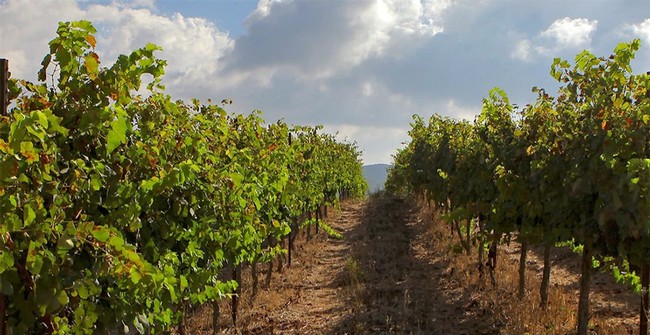
It's not the easiest grape to grow, being susceptible to powdery mildew, but it rewards winemakers with beautifully aromatic and elegant wines. Roussanne is a key ingredient in white wine blends, mostly with Marsanne, but also with varietals like Viognier, Sauvignon Blanc, Chardonnay etc., which complement it and elevate the taste to the next level. All these varietals are also successfully cultivated in Israel, thanks to its unique climate and terrain.
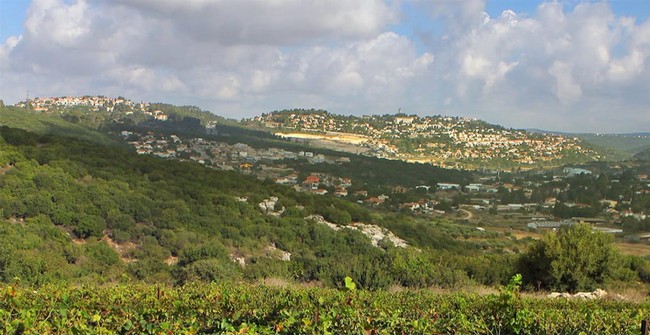
Aromatic Profile and Characteristics
Roussanne-based blends boast a captivating bouquet. Roussanne on its own is characterized by herbal, tea-like aromas, with a delightful mix of fruity notes like apricot and lime, intertwined with honeysuckle and iris. On the palate, it typically shows pears and honey with notable intensity. When blended with Marsanne, it provides aromatic intensity, complementing its richer counterpart's structure and body.
The taste profile reflects this varietal's noble character, offering a good balance of acidity and a captivating aroma. Depending on the origin and harvest time, the acidity can range from medium to high, and Roussanne-based wines are typically light in sweetness.
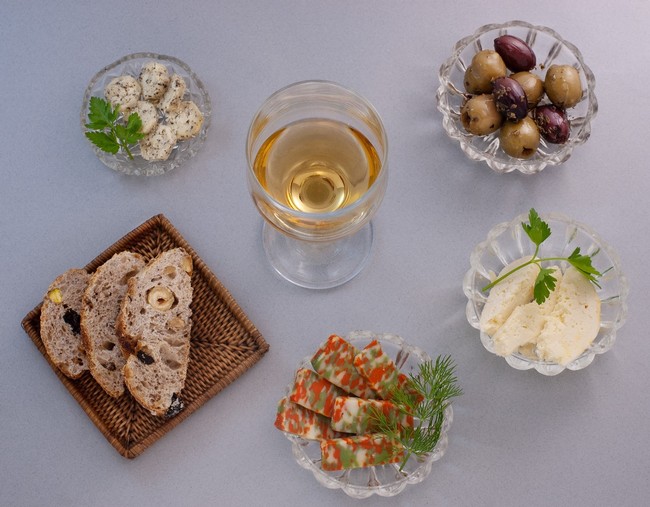
Despite its limited size, Israel packs a surprising punch when it comes to Roussanne diversity. This is thanks to the unique variations in climate and soil types found across its various regions. Furthermore, the diverse craftsmanship of Israeli winemakers allows them to showcase their unique styles in every bottle.
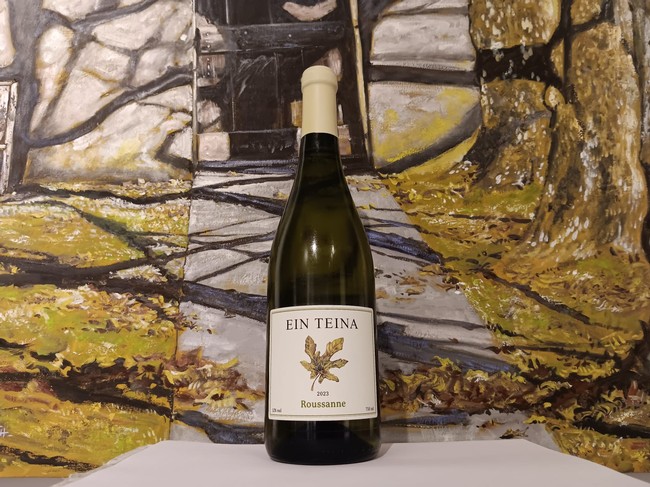
Our newest arrival: Ein Teina Roussanne, a wine never before imported to the States! A pure unblended Roussanne is a rare find, as Roussanne grapes are challenging to cultivate and more often used in blends.
This unique wine comes from a small boutique winery and was meticulously crafted using two harvests of the same grape varietal to achieve perfect balance. The first harvest produced grapes with lower sugar levels, resulting in a wine with vibrant acidity, crucial for its structure. Two weeks later, a second harvest brought riper grapes bursting with varietal character.
These grapes hail from the Southern Golan, known for its deep volcanic soil. This soil acts like a natural reservoir, retaining water during the hot summer months and preventing vine stress. This allows for crucial "hang time" – the extra time grapes spend on the vine to their final maturation, fully developing their flavor profile.
The wine undergoes several months of aging "sur lie" with batonnage. This technique enriches the body of the wine and adds complexity. The result is a stunning aromatic wine with an elegant fruity-herbal character. It strikes a balance between freshness and ripeness, avoiding an immature dilution or overly tropical character.
Please note that Ein Teina is a non-Kosher winery.
This food-friendly wine is intended to complement your meal, letting the flavors of your dish shine. Don't miss your chance to be among the first in the U.S. to try Ein Teina's Roussanne – we highly recommend it!
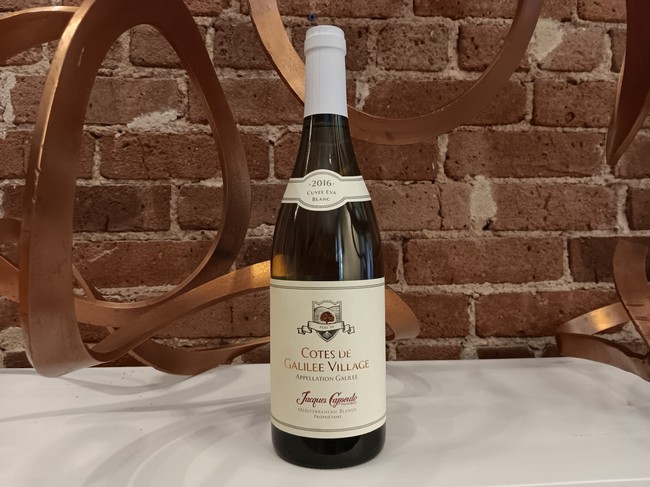
With the exception of Ein Teina winery's unique unblended Roussanne, most Israeli Roussanne expressions come in blends. This reflects the country's rich tradition of crafting blends for all palates, drawing on the creative visions of vintners and the diverse grape qualities produced in Israel's distinct wine regions.
Restaurateur Jacques Capsouto’s concept was to grow French-originated varietals of grapes in the Western Galilee, and make blends in the Southern Rhone style, less fruit-forward, with strong minerality. These are classic blends that feature Roussanne and Marsanne alongside other French varietals. The resulting Roussanne blends turned out to be elegant and refreshing, easy to drink and versatile food companions, particularly with French cuisine.
We recommend two Capsouto Roussanne blends – Albert Grand Vin Blanc and Eva Blanc. These wines are kosher.
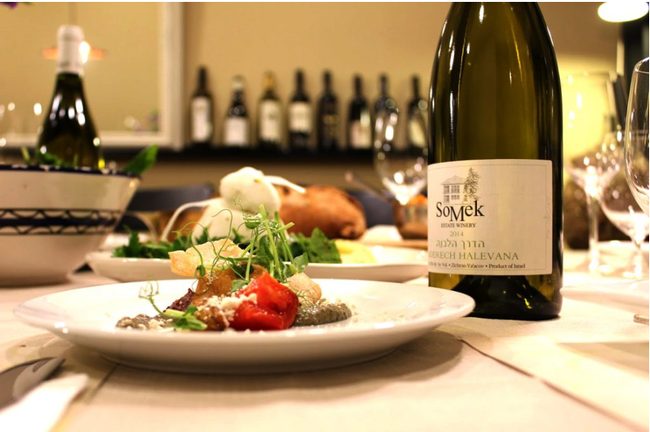
A boutique winery Somek, located in one of Israel's oldest wine-making regions on the Mediterranean coast, takes a completely different approach with Roussanne. Led by its fifth-generation vintner, the winery crafts a rich and almost creamy Roussanne blend called “Hadereh Halevana” (White Road) bursting with intense fruity aromas and hints of ginger and honey. A year spent in oak barrels followed by two years in the winery results in a velvety smooth taste with notes of pine, roasted sesame seeds, and a lingering caramel aftertaste.
Somek wines are certified vegan.
They are non-kosher.
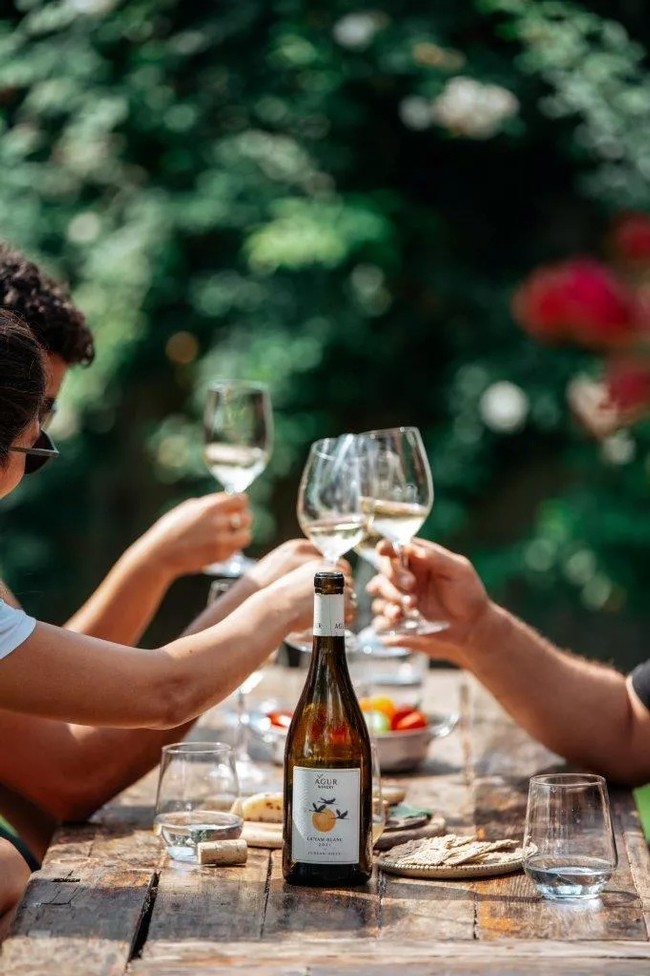
Another small but outstanding Israeli winery, Agur, is situated in the historic Elah Valley, where David famously defeated Goliath. Here, they craft Roussanne blends with yet another distinct style. These wines are complex and rich, yet balanced by a refreshing, crisp minerality – a true reflection of the local terroir through the blend's different varietals.
Agur wines are kosher.
Each of these diverse Roussanne expressions finds its perfect food pairing, waiting to be discovered.
Roussanne: A Culinary Canvas
All Israeli Roussanne blends are beautifully aromatic and food-friendly wines. Unoaked styles boast a lighter body and bright acidity, while oaked versions develop a richer texture. Let's explore how to unlock different Roussanne blends potential through delicious pairings.
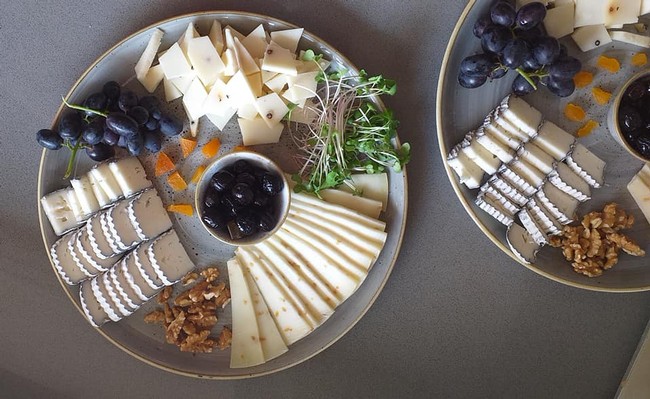
Cheeseboard Delights
Roussanne complements a delightful range of cheeses. Soft and creamy options like Brie or Camembert create a luxurious contrast with the wine's acidity. For a bolder pairing, explore hard cheeses like Gruyere, a young cheddar, or even a tangy Comté.
Forget the struggle to find the perfect cheese pairing with white wine. Look no further than Agur Layam Blanc. This Roussanne-led blend, featuring Sauvignon Blanc, Chardonnay, and Viognier, boasts a luxuriously complex character.
The secret lies in its nine-month slumber in barrels, where fermentation and aging on lees imbue it with richness. This depth of flavor makes Agur Layam Blanc a fantastic match for a variety of cheeses. Holding its own against strong cheeses without overpowering delicate varieties, it becomes an ideal choice for a cheese plate featuring a diverse selection.
Enjoy it with milder options like cheddar, Brie, Monterey Jack, or Triple Crème. It beautifully complements herb-coated goat and sheep milk cheeses as well. But Agur Layam Blanc doesn't shy away from bolder options. Its richness stands up to the sharpness of Parmigiano-Reggiano, creating a harmonious balance on the palate.
Don't forget crusty bread – its texture adds another dimension to the experience and allows the flavors of both the cheese and the wine to linger on the tongue.
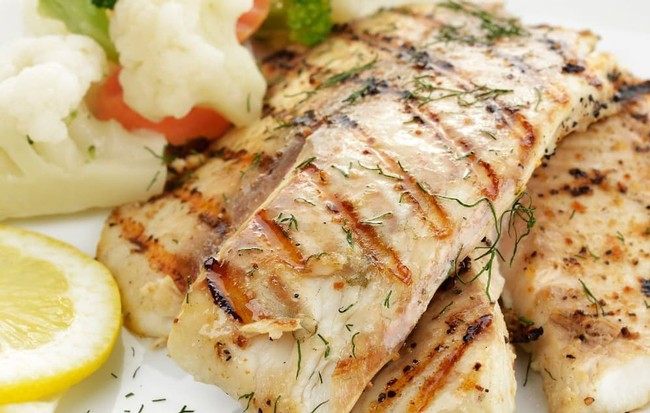
Fish And Seafood
Beyond cheese, all Roussanne wines shine alongside white fish.
Elegant Roussanne blend Capsouto Cuvée Albert Grand Vin Blanc could be a great match for various fish dishes. This "Grand Vin Blanc," named after the winemaker's brother Albert, a Tribeca restaurateur, is primarily Roussanne with addition of Clairette and Marsanne varietals. The Roussanne undergoes aging in French oak barrels, adding complexity to the wine. Roussanne blended with Marsanne is the classic pairing for a reason. Marsanne contributes richness and body, lending a weight that complements Roussanne's natural elegance. Its subtle sweetness also helps balance the bright acidity of Roussanne, creating a harmonious and complex wine.
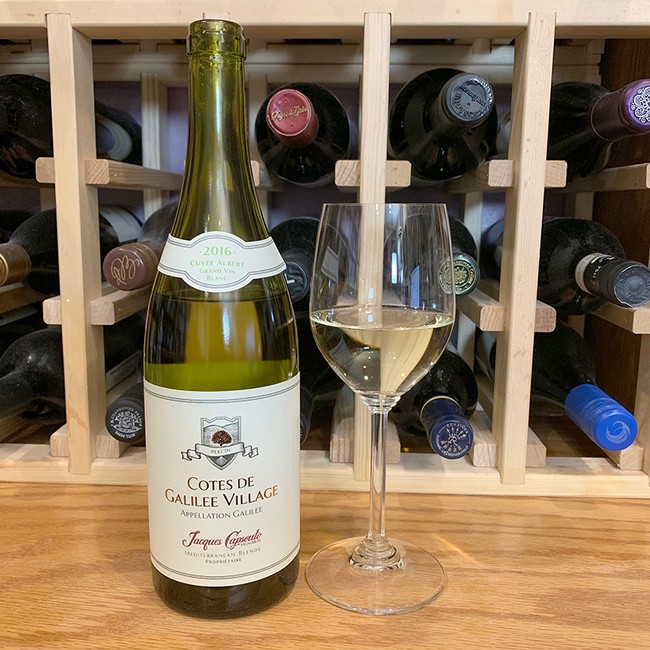
Medium-bodied with a long finish, Capsouto Cuvée Albert Grand Vin Blanc unfolds a complex bouquet. Mineral aromas mingle with green apple, pear, white flowers, and white tea. This perfectly balanced, old-world blend showcases a symphony of tart peach and apricot on a lingering finish, where the minerality echoes with hints of flint and stone. The wine's complex interplay of flavors create a beautiful pairing with lobster bisque, echoing the dish's own depth. Grilled scallops with saffron cream sauce or steamed crab legs dipped in clarified butter are other delightful accompaniments.
It would also shine alongside various white fish, from the delicate flavors of cod or halibut to the heartier texture of grouper. Pan-sear your fish with a touch of butter and lemon for a classic pairing, or experiment with a light poaching method for a lighter experience.
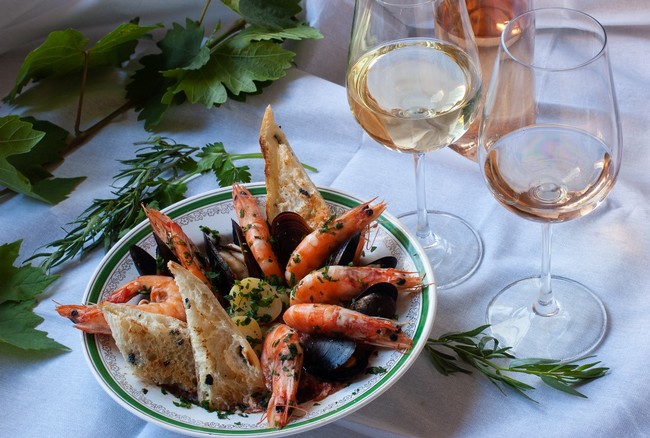
A lighter Ein Teina Roussanne might just be the ideal partner for bouillabaisse, the jewel of French Mediterranean cuisine. This rich seafood stew, simmered with fish, shellfish, onions, tomatoes, olive oil, garlic, herbs, and a hint of saffron, explodes with flavor. Each ingredient becomes a delightful dance partner for this versatile Roussanne. Its floral and fruity notes complement the broth's flavors beautifully. It would enhance the delightful flavors of the bouillabaisse without overpowering it.
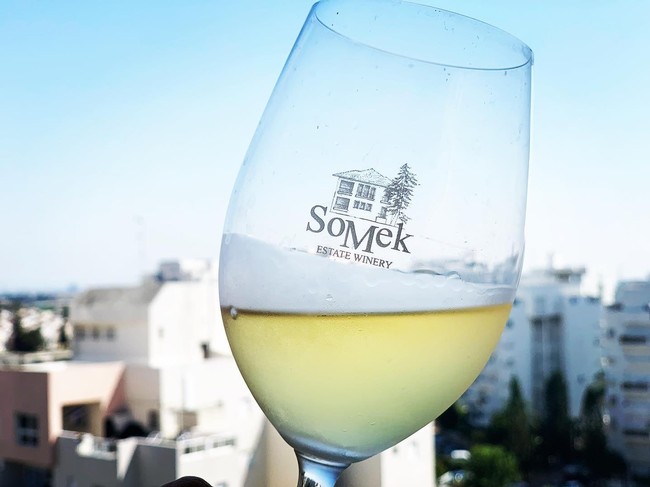
Poultry Perfection
Roussanne is a natural partner for poultry. Season your chicken with fragrant herbs like thyme or oregano, allowing the wine to complement both the dish's flavor and aroma.
Rich poultry dishes like Chicken Francese, with its tangy lemon pan sauce, find a beautiful match in a mature oaked Roussanne like Somek White Road. This harmonious blend of Roussanne, Viognier, & Chenin Blanc comes from vineyards cultivated by the same family since 1882! A year in oak barrels followed by two years in the winery imbues the wine with remarkable complexity.
The wine’s vivacious interplay of blossoming orchard, tart nectarine, pear, grapefruit, and lime, is accompanied by notes of ginger, honey and Meyer lemon. A touch of minerality refreshes the aftertaste, inviting you to savor the moment. Somek White Road's creamy yet fresh character creates a dream pairing for chicken with lemon. Wine’s citrus notes echo the dish’s lemon zest, while its subtle hint of buttery richness complements the sauce. Slight note of hazelnuts in the wine adds another layer of complexity, creating a truly harmonious pairing that elevates both the food and the wine.
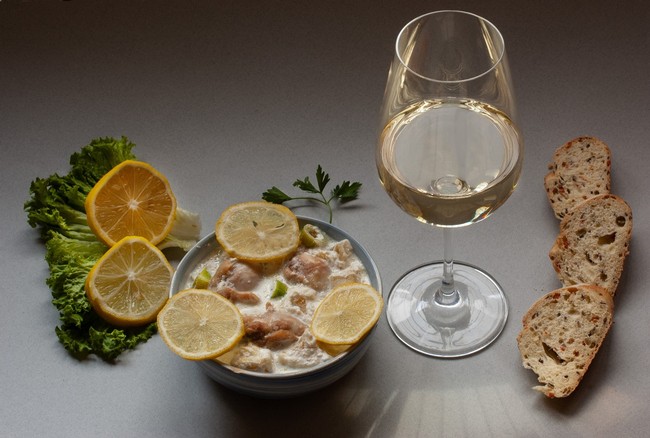
Beyond Chicken
Roussanne also elevates other poultry dishes. Try a rich duck confit or indulge in a luxurious goose roasted with caramelized onions and apples. For a festive occasion, pair a mature Roussanne with a turkey roasted with herbs and vegetables.
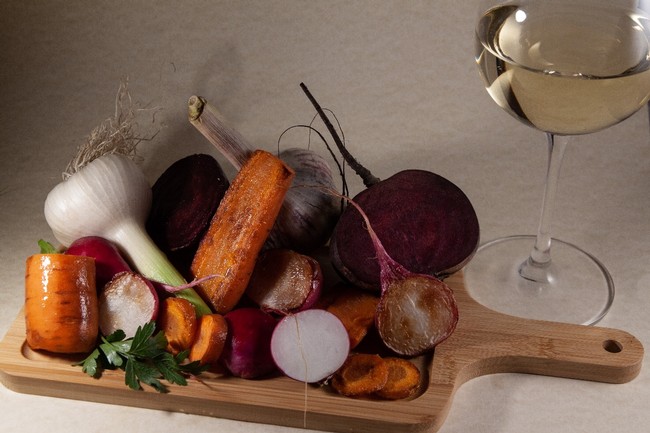
Vegetable Symphony
Roussanne doesn't shy away from vegetables!
Pair light or medium-bodied Roussanne with roasted root vegetables like parsnips and carrots. Toss them with olive oil, thyme, and a touch of honey for a touch of sweetness. Winter squashes roasted with a dash of cinnamon become an even more delightful match.
For a richer experience with more mature Roussanne, explore creamy vegetable dishes. Butternut squash ravioli with a sage and brown butter sauce or a creamy cauliflower gratin with Gruyere cheese become showstopping companions.
Roussanne's versatility extends to vegetarian delights. Risotto with butternut squash or pumpkin becomes a luxurious main course when paired with oaked Roussanne. The wine's richness complements the creamy texture of the risotto and the sweetness of the squash.
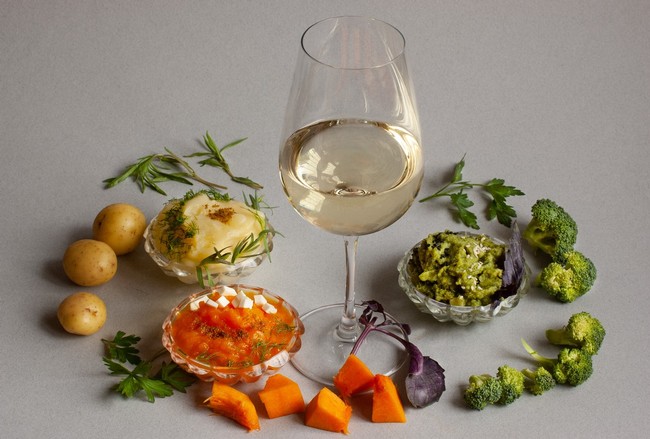
Yam and Potato Pairings
Don't overlook the humble potato or yam! Mashed potatoes with roasted rosemary chicken and a splash of cream in the mash become an elevated comfort food experience when paired with a lighter Roussanne like Ein Teina’s. For an even richer experience, try creamy potato or yam purees infused with herbs like chives or roasted garlic.
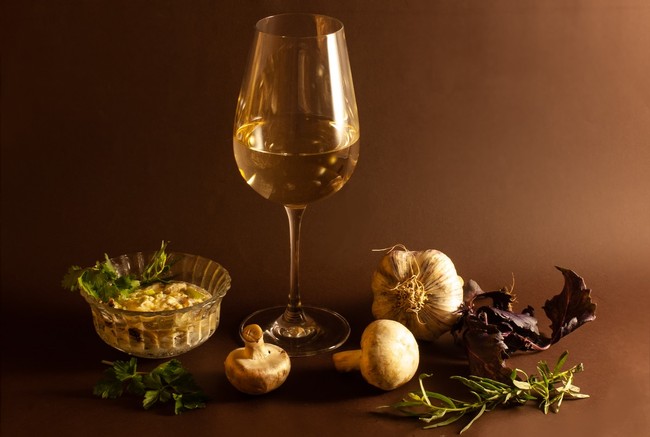
Soups and Roussanne: A Symphony of Comfort and Flavor
Roussanne's versatility extends to the comforting world of soups! Its bright acidity creates a delightful harmony with creamy textures, making it a perfect partner for a variety of dishes.
Creamy Delights
Indulge in a luxurious pairing with creamy mushroom soup. The wine's acidity cuts through the richness of the mushrooms, allowing their earthy notes to truly shine. Similarly, explore a creamy cauliflower or broccoli soup, where Roussanne's vibrant character complements the subtle sweetness of the cauliflower or broccoli.
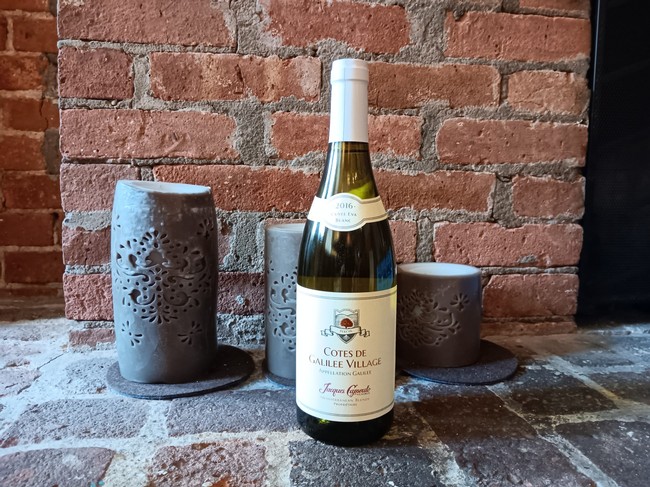
Unexpected Brilliance: French Onion Soup
For those seeking a more adventurous pairing, Roussanne blends can be a delightful partner for French onion soup. We suggest trying it with Capsouto Cuvée Eva Blanc, a wine made mainly from Grenache Blanc, balanced with a smaller amounts of Clairette, Roussanne, and Marsanne. This Southern Rhône-style white wine, named after the winemaker's mother in a gesture of love and respect, is crafted with remarkable skill and elegance. It boasts a soft nose of white peach and lemon zest, followed by flavors of peach, apricot, fennel bulb, and a hint of rye on the palate. It is fresh, with good acidity and a well-balanced finish.
The wine's acidity acts as a refreshing foil to the soup's robust flavors. Imagine juicy citrus and hints of Mediterranean herbs dancing across your palate, cutting through the richness of caramelized onions, melty cheese, and savory broth. Despite its boldness, the soup's texture finds harmony with Roussanne's creamy character. Most surprisingly, the grassy and herbaceous notes, a signature contribution of the Roussanne in this blend, find a hidden connection with the savory onion flavors, creating a delightful experience. This unexpected pairing showcases Roussanne's versatility and ability to elevate classic dishes, even when it plays a supporting role in the blend.
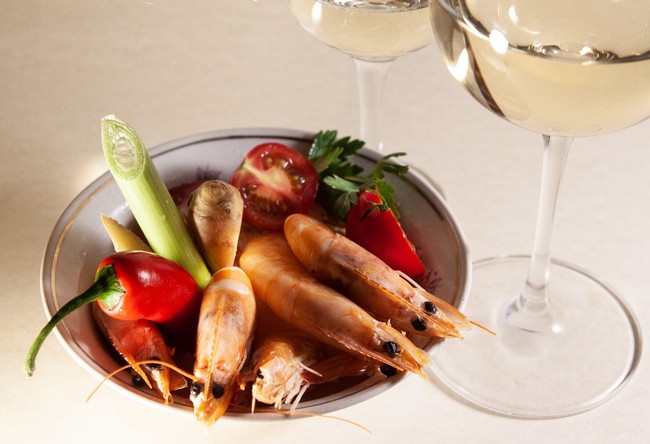
A Spicy Adventure: Thai, Curries and Creole
Roussanne boasts a surprising talent: it can handle spice beautifully! Take, for example, Agur Blanc, an aromatic and beautifully structured blend of Chenin Blanc, Roussanne, and Viognier from the Judean Hills. This wine exemplifies this strength, standing up to the bold aromatics like lemongrass and ginger common in Southeast Asian cuisine. Its crisp character acts as a refreshing counterpoint, cutting through the richness and cleansing your palate, preventing that heavy feeling you can get from spicy dishes.
Dive into the world of Thai curries. Focus on lighter options like yellow curries featuring chicken and vegetables, or green curries with shrimp and bamboo shoots. These dishes will allow the nuanced flavors of Roussanne to shine.
Travel down to Louisiana and explore an unexpected match for Roussanne blends: the bold flavors of Creole and Cajun cuisine! This pairing might be for the more adventurous, but with the right Roussanne, it can be truly rewarding. Gumbo is a complex dish with a rich, spicy personality. It demands a wine that's bold enough to stand up to the gumbo's intensity, yet nuanced enough not to overpower its unique flavors. Oaked Roussanne blend like Somek White Road or Agur Layam Blanc step up to the challenge. Their balanced acidity cuts through the gumbo's richness, while not overwhelming its flavor.
Balance is key to a perfect pairing. Opt for dishes with a medium spice level to avoid overwhelming the delicate flavors of Roussanne. This allows the aromatic spices to shine alongside the wine, revealing the magic of this versatile white.
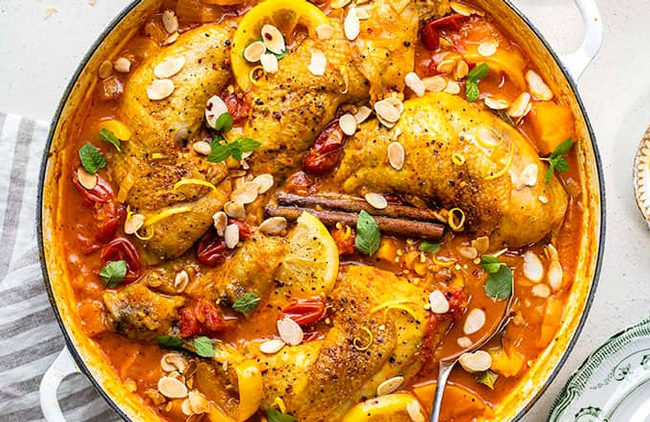
Aromatic Adventures: Tagines and the Middle East
Roussanne's affinity for bold flavors extends to the Middle East. Its savory notes find a delightful echo in dishes featuring cilantro, cumin, ginger, and garlic. Don't miss pairing Roussanne with tagines, especially those featuring poultry. Moroccan chicken tagines simmering with apricots, almonds, and a touch of cinnamon become a true symphony of flavor when paired with a Roussanne blend. The wine's crisp acidity cuts through the sweetness of the dried fruit, while harmonizing with the warm spices that grace tagines. Explore other dishes from the region, like grilled chicken or fish with herb rubs, or eggplant dishes, or creamy hummus, to discover a world of exciting new pairings.
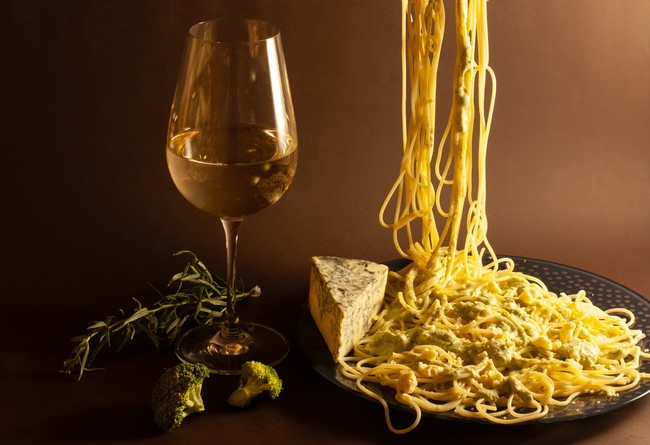
Roussanne's Italian Journey
Creamy pasta dishes and risottos are practically begging for a perfect partner. Look no further than Somek White Road with its rich texture and notes of tart fruit, sweet butter, and a hint of honey. It beautifully complements the cheesy richness of these meals, while the wine's subtle floral notes playfully dance with the fragrant herbs often used in Italian cooking.
So, next time you're exploring Italian cuisine, don't be afraid to reach beyond the typical Pinot Grigio. Look for a flavorful Roussanne blend from the Israeli Mediterranean shore, and discover a world of flavor pairings waiting to be explored.
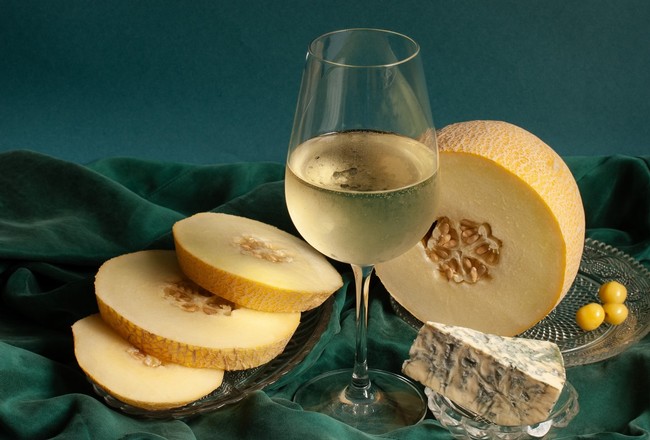
Roussanne's Rendezvous with Melon
One more gourmet pairing to tempt your palate: lighter Roussanne blends, like Capsouto Cuvée Eva Blanc, with a delectable melon. Delicate notes of spice and honeysuckle in the wine complement the aromatic fruit, creating a harmonious and refined dessert duo.
~~~~~~~~~~~~~~~~~~~~~~~~~~
A Few Words on Wrong Pairings
While Roussanne is wonderfully versatile, there are a few exceptions to keep in mind. Avoid extremely smoky or charred dishes, as the smokiness can overpower the wine's delicate charm. Excessively spicy dishes with overpowering chilies can also be a mismatch, as the heat can overwhelm the wine's flavors. Very light and simply prepared dishes might get lost against a full-bodied oaked Roussanne blends. Finally, avoid overly sweet dishes. The wine's acidity can clash with the sweetness, creating an unpleasant imbalance on the palate. With these small considerations in mind, you're ready to embark on a delicious adventure with Roussanne!
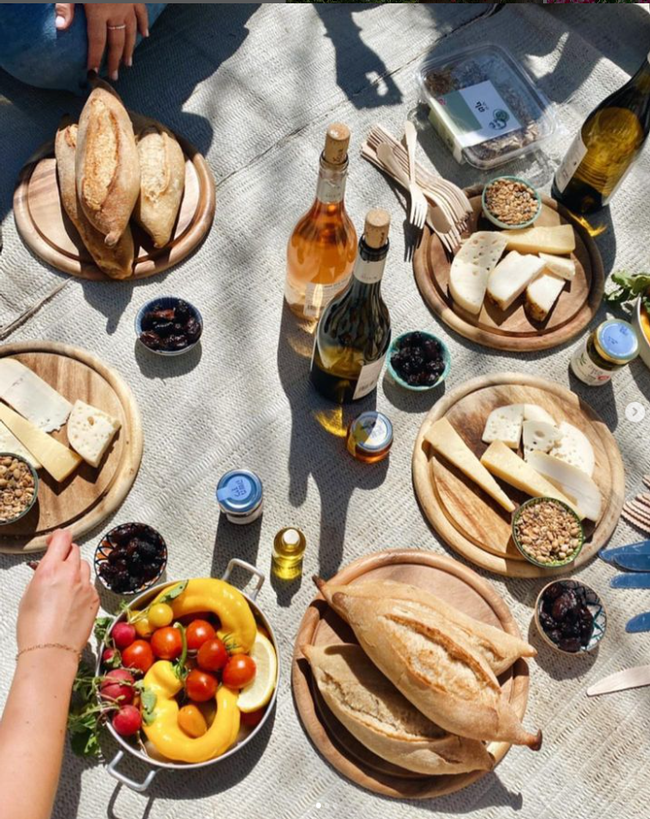
In Conclusion
Roussanne is a food-lover's dream, waiting to be explored. From cheese plates to fish dishes, creamy pastas, spicy adventures, and flavorful global cuisine, this versatile wine offers a delightful pairing for every palate. So, raise a glass and embark on your own delicious journey with Israeli Roussanne!
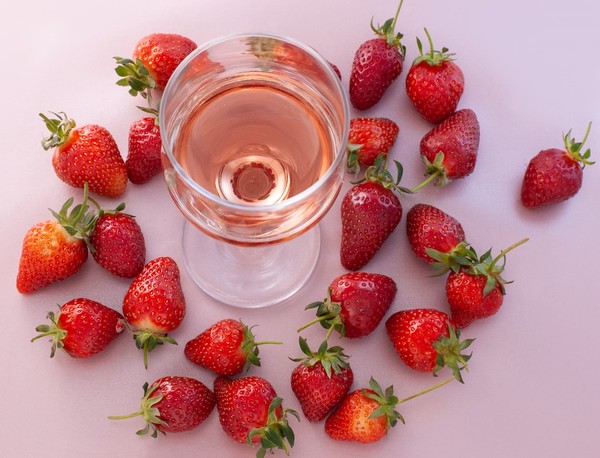
Summer is the perfect time for Rosé wine: beautiful, refreshing, and bursting with flavors of fresh strawberries and other delicious fruit. It's a fantastic complement to light dishes, making it a popular choice for warm-weather gatherings.
Rosé has become a global phenomenon, attracting a devoted following. But how many of these fans are truly familiar with the vast diversity of Rosé? There's a whole world to explore within this seemingly simple pink drink. Different types of Rosé exist, with a spectrum of shades ranging from the palest blush to a deeper, more pronounced pink. The grape varietals used can vary greatly, and the winemaking techniques employed to craft Rosé can be quite diverse as well.
Mastering these factors opens the door to a world of delicious discoveries. Each rosé style offers a unique taste adventure waiting to be explored. What delicious dishes will unlock the magic of different Rosé styles, creating a perfect summer feast?
And finally, the age-old question: who deserves our gratitude for this delightful "drink of the gods"? Let's delve deeper and discover the fascinating world of Rosé!
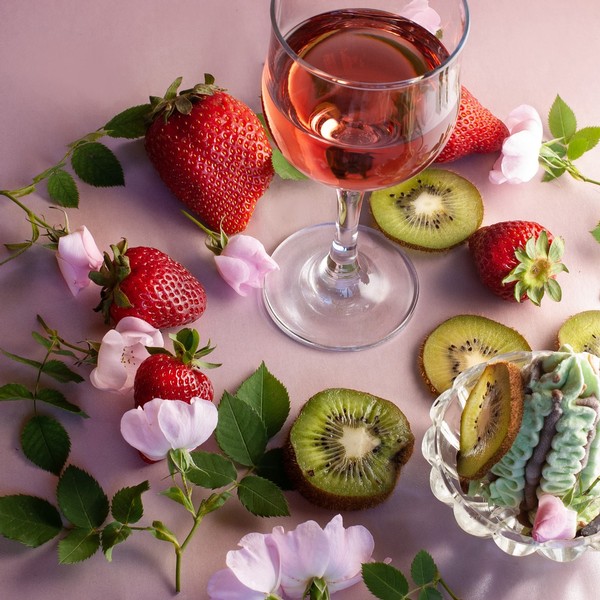
Beyond the Blush: Unveiling the Colors of Rosé
Unlike what many believe, the captivating pink color of Rosé doesn't directly indicate sweetness. It's all about the relationship between red grape skins and the juice during fermentation. The briefer the contact, the paler the pink. Conversely, longer contact results in deeper shades. This delicate dance unlocks a fascinating spectrum of Rosé styles:
Pale Pinks: Imagine a summer breeze carrying refreshing notes of mint, grapefruit, and strawberries. These characteristics are hallmarks of pale pink Rosés, often crafted from Pinot Noir, Carignan, or Zinfandel grapes. Their light body makes them perfect companions for grilled vegetables, lighter seafood dishes, or simply enjoying a sunny afternoon.
Blush Pinks: Merlot, Grenache, and Sangiovese grapes lend their personality to blush pink Rosés. These wines boast enticing flavors of sweet cherries, raspberries, and blood oranges. Their slightly fuller body allows them to stand up to richer dishes like creamy pastas, grilled chicken, or even lighter red meat stews.
Darker Pinks: For those seeking bolder flavors, darker pink Rosés crafted from Cabernet Sauvignon or Tempranillo grapes offer a delightful surprise. Dark berry notes mingle with hints of spice, creating a complex flavor profile. These robust Rosés can hold their own against grilled meats or poultry.
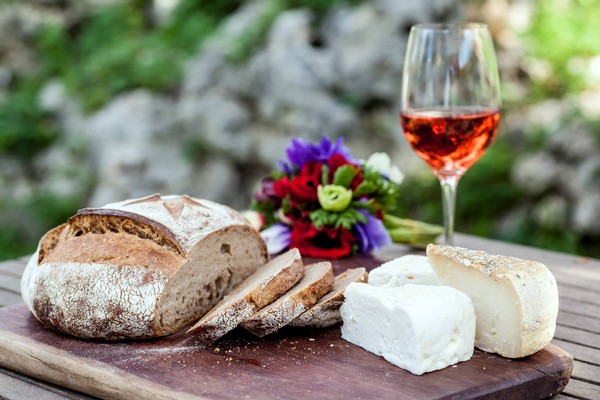
Making Rosé: Exploring the Techniques
The final shade of a Rosé isn't just about the grape varietals used. Winemaking techniques have a major impact on the color. Let's explore the four main ways Rosé is made:
Maceration: This popular method involves allowing red grape skins (called “must”) to rest briefly with the clear juice. This "soaking" extracts color, flavors, aromas, and structure from the skins, resulting in a deeper pink wine with bolder personalities and pronounced flavors.
Direct Press: In this speedy approach, the red grape skins have minimal contact with the juice, similar to making white wine. A hint of color remains, creating the lightest-colored Rosés, like pale-salmon, with refreshing citrus notes and delicate strawberry hints. Specific flavors can vary by grape type.
Saignée (or "Bleeding"): This less common technique borrows from red wine production. During the early stages, some juice is "bled" off, or simply extracted, and used to create Rosé in a separate vat. This method can yield unique rosés with distinct personalities, often resulting in some of the best-aging Rosés as well as the darkest and most tannic ones.
Blending: While seemingly simple (red + white = Rosé!), blending fermented red and white wines is prohibited in most European wine regions (AOP) with strict regulations. The exception? Champagne! Here, blending is the preferred method for crafting their iconic Rosé Champagne. In some New World regions with less rigid rules, blending can also be used to create Rosés, offering a range of styles.
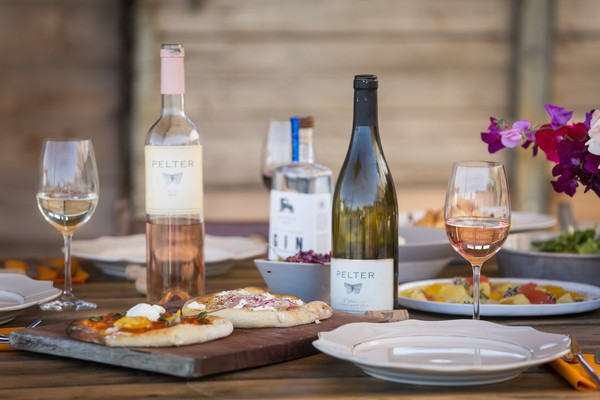
A Culinary Chameleon: Rosé's Unexpected Pairing Power
Rosé's versatility extends far beyond its refreshing summer appeal. Its ability to pair beautifully with a wide range of foods makes it a true culinary chameleon. Here's a glimpse into the world of food and Rosé pairings:
Light and Fresh: Take your next barbecue to the next level! Lighter-bodied Rosé styles complement grilled vegetables, fresh salads, and delicate seafood dishes like seared scallops or grilled salmon.
A Touch of Spice: Don't shy away from bolder flavors! Rosés can handle the heat of spicy cuisine. Experiment with Indian curries, Thai stir-fries, or even Mexican dishes.
Mediterranean Match: Rosé shines alongside the vibrant flavors of the Mediterranean. Explore pairings with Greek moussaka, Lebanese mezze platters, Israeli falafel, or a simple plate of hummus and grilled vegetables.
Beyond Summer: While Rosé is a perfect wine for warm weather, its versatility extends year-round. Explore pairing darker Rosés with stews, roasted vegetables, or even grilled lamb.
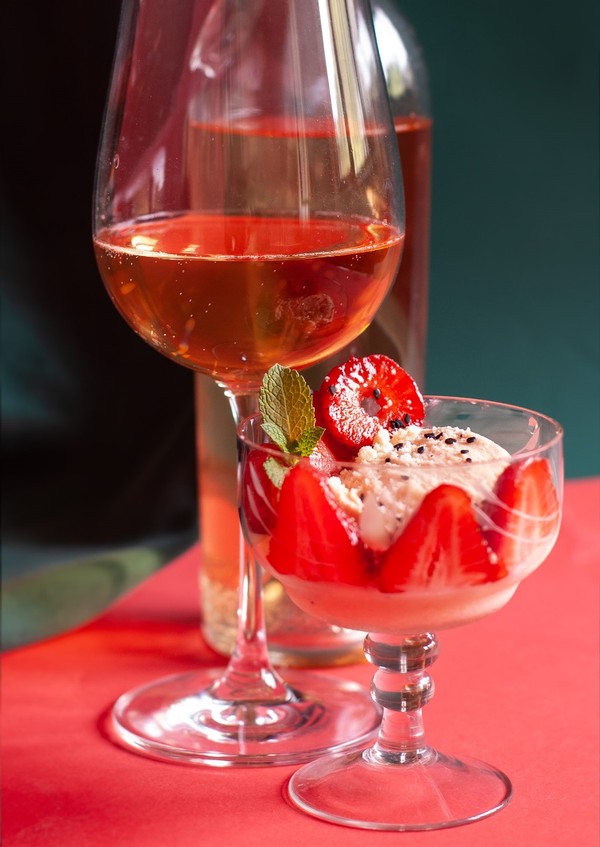
Respecting the Chill
To fully appreciate the delicate flavors and aromas of Rosé, temperature matters. Treat Rosé like a white wine, serving it between 44-55°F. This allows the wine to unfold its complexities, ensuring a delicious experience with every sip.
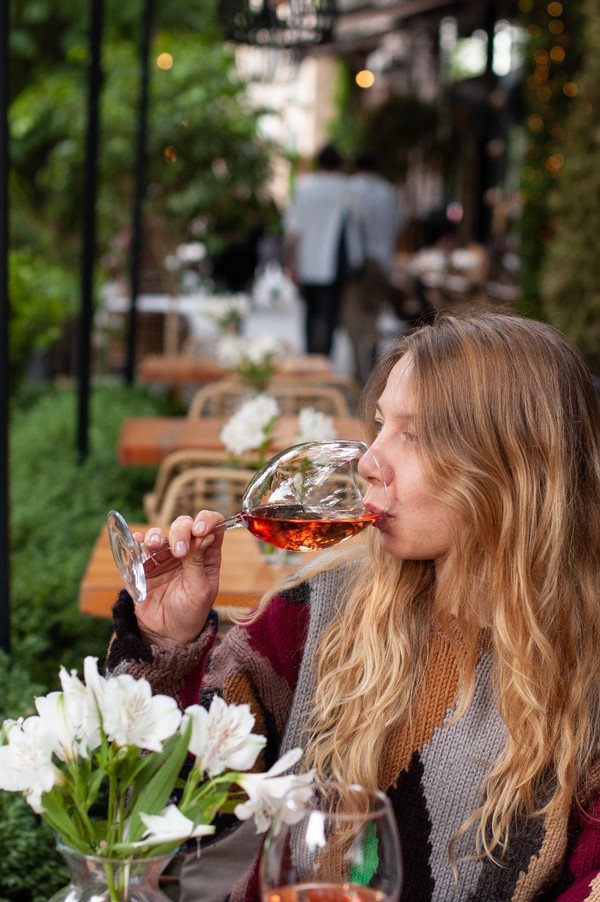
Uncork the joy of summer with a glass of Rosé! Unlike many red wines, Rosé is meant to be savored young, bursting with vibrant flavors and enticing aromas. Think of it as a bouquet of freshly picked flowers.
Vintages 2022 and 2023 are your prime targets! Rosé's popularity means these may not last until winter. So, embrace the season and embark on a delightful Rosé adventure.

A Toast to the Past: The Enduring Legacy of Rosé
Uncorking the history of Rosé takes us on a journey that may stretch back millennia, possibly to the very beginnings of wine itself. Some scholars believe the earliest wines, made by simply fermenting grapes with the skins on, were inherently pink. While it's unlikely they tasted like the refined Rosés we know today, it hints at Rosé's claim as one of the most ancient forms of wine.
The documented history of Rosé wine begins with the Greeks from Phocaea (ancient Ionian Greek city, modern-day Turkey) bringing wine grape vines to Massalia (modern-day Marseille in southern France) in the sixth century BC to make Rosé wine. They believed that pale pink wine was superior to either red or white. The people of the region now known as Provence embraced this new style of wine, further refining the methods and laying the groundwork for the region's long-standing reputation for Rosé production.
From Provence, Rosé's popularity spread throughout the Mediterranean. Winemakers in other countries experimented with this new style, and even the Romans, known for their love of full-bodied reds, found themselves captivated by Rosé's charm. This early adoption by Mediterranean cultures helps to explain why the region continues to be a source of some of the world's most exceptional Rosé wines today.

Beyond Provence: A World of Rosé Delights
While Provence may reign supreme in the world of Rosé, the sun-drenched shores of the Mediterranean hold a treasure trove waiting to be discovered. From Spain and Italy to Greece, the origin of Rosé, a tradition of crafting this ancient wine continues. Now, Israel, another sun-kissed Mediterranean nation with a rich winemaking history, is stepping into the spotlight with its own captivating selection of Rosés.
From vineyards nestled in Israel's high altitudes to those gracing the slopes overlooking the sparkling Mediterranean Sea, and even extending to the heart of the desert, Israel offers a diverse range of growing conditions. This variety results in unique and captivating Rosés, each with its own story to tell.
Here are five Israeli Rosés to tempt your taste buds, with options ranging from light and fruity to richer styles perfect for food pairings:
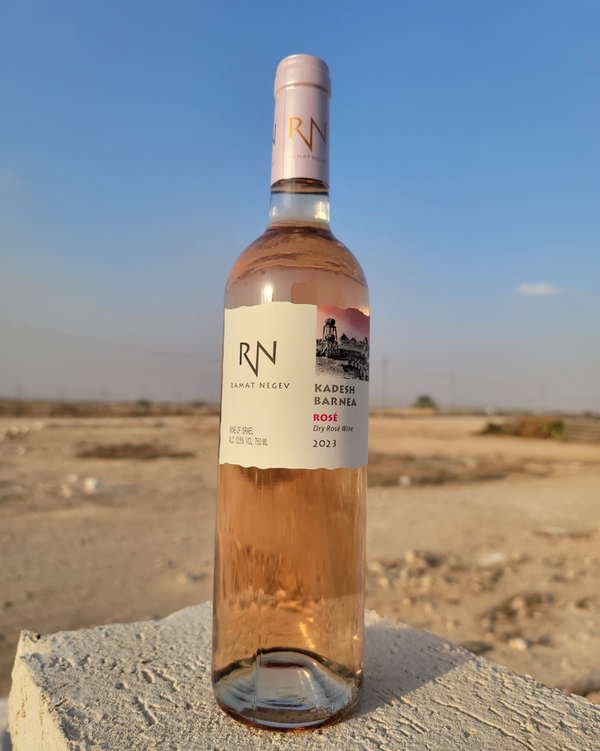
Ramat Negev Kadesh Barnea Rosé (Light & Fruity)
Made from 100% Cabernet Franc grapes, boasting a beautiful light pink-orange color.
A burst of strawberries with hints of grapefruit, raspberry, cranberry, and green apple.
Lively acidity keeps it refreshing, with a delightful mellow finish and a whisper of peach.
Perfect for fish, chicken, well-seasoned dishes, cheese platters (especially blue cheese), and even desserts!
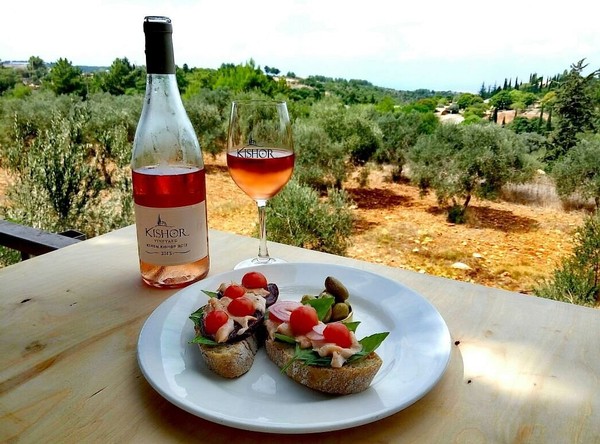
Kishor Rosé (Dry & Elegant)
Crafted from 100% Grenache grapes, offering a dry, graceful, and lively taste.
A beautiful salmon color with refreshing fruit notes.
Hints of summer red fruit, citrus, sun-kissed Mediterranean herbs, and a touch of minerality for perfect balance.
Ideal for appetizers like smoked salmon, cream cheese, and fresh puff pastry.
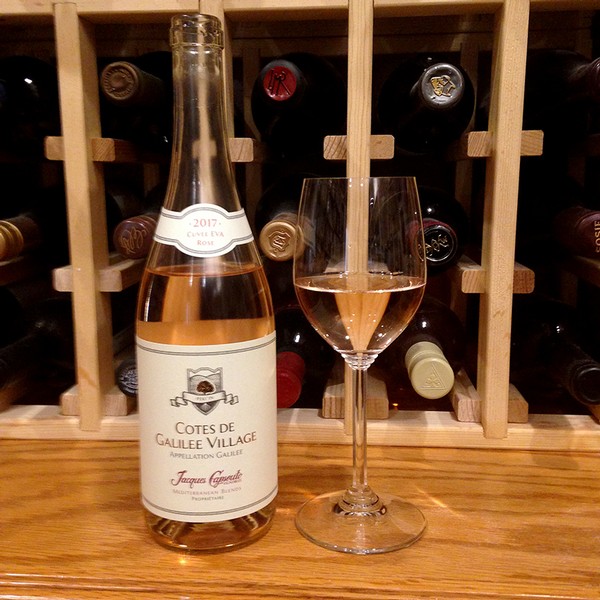
Capsouto Cuvée Eva Rosé (Provence-style)
This charming light-bodied Rosé evokes the essence of Provence with its beautiful salmon color and delicate flavors of berry fruit, apricot, pear, and pineapple.
Crisp acidity keeps it incredibly refreshing.
Pairs well with grilled or roasted vegetable dishes such as ratatouille, salads with fruit, and grilled seafood such as salmon or tuna.
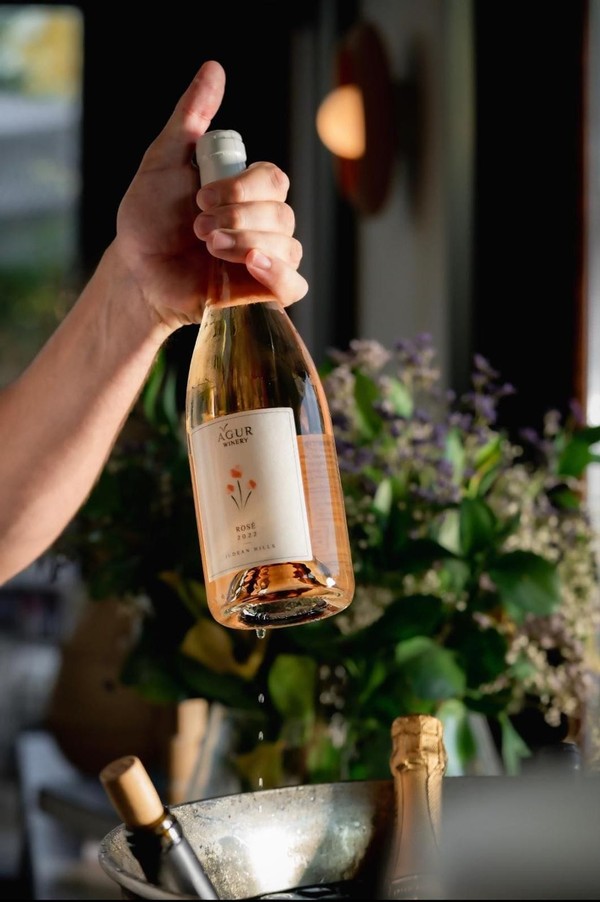
Agur Rosé (Rich & Food-Friendly)
A blend of Mourvèdre, Grenache, Marselan, and Cabernet Franc, it boasts a medium body with fresh acidity.
Expect aromas of orange and lemon peel, Rosé petals, and minerality, followed by flavors of pear, peach, citrus, and red fruits.
Perfect for a wider range of dishes, from meat and fish to simply enjoying on its own near the pool.
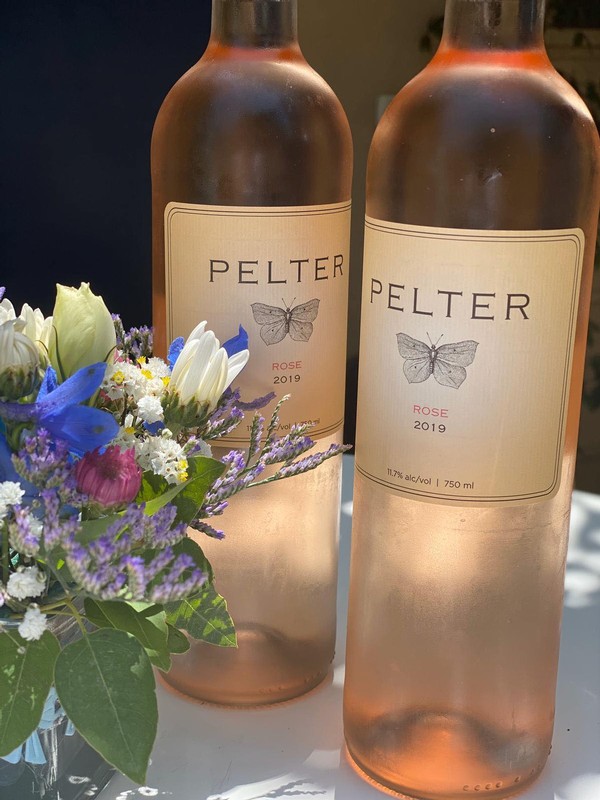
Pelter Rosé (Light & Refreshing)
Produced from Grenache, Sinsaou, and Counoise grapes, Pelter Rosé offers a light and refreshing drinking experience.
Delicate pink in color, it bursts with aromas and flavors of red grapefruit, strawberry, and lemon.
The soft, long finish makes it a perfect patio sipper.
A delightful partner to: seafood, salads, fresh fruit, and sweet pastries.
We're thrilled to announce a new shipment of fresh Rosés has just arrived!
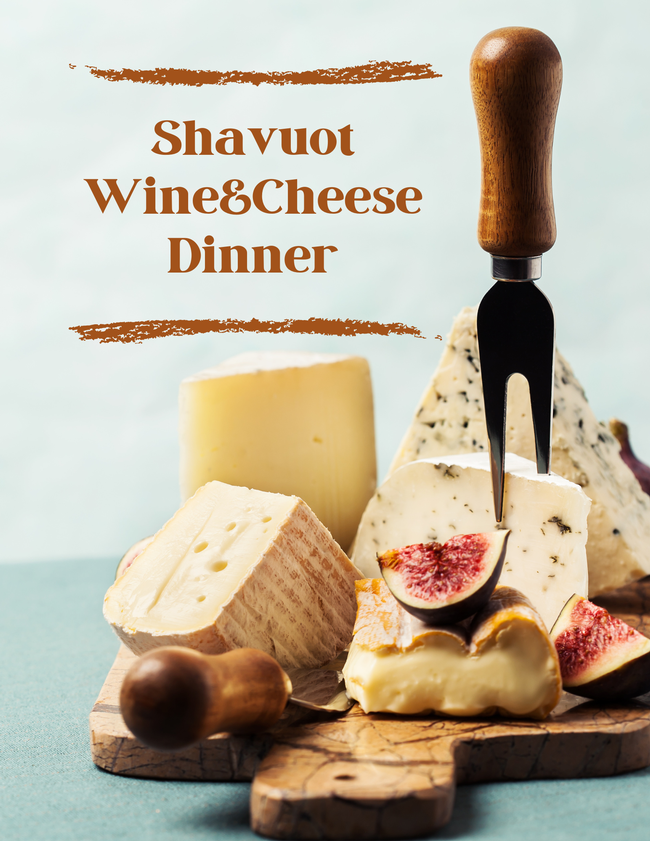
Shavuot, a holiday commemorating the receiving of the Torah at Mount Sinai, falls this year from sundown on Tuesday, June 11th, to Thursday night, June 13th. Though often overshadowed by its fellow pilgrimage festivals, Passover and Sukkot, Shavuot holds a special place in Jewish tradition
Observed seven weeks after Passover, Shavuot coincides with the spring harvest. Traditionally, this harvest season was marked by a pilgrimage to Jerusalem, where Israelites offered their first fruits to God in thanksgiving.
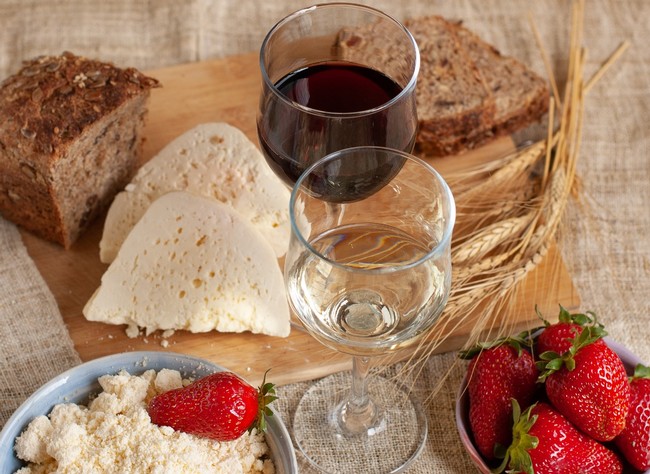
Shavuot also features a unique custom: enjoying dairy foods during the holiday. There are several explanations, but a popular one connects it to the Promised Land, a land "flowing with milk and honey." Blintzes, kugel, cheesecake, ice cream, and of course, cheese, are all popular Shavuot dishes!
While unlike Purim and Passover where drinking is a mitzvah, Shavuot doesn't have a specific requirement for alcohol. However, a fascinating medieval European custom involved keeping a beer barrel in synagogues during all-night Torah study session on Shavuot. Perhaps this practice reflects the belief that a little refreshment can enhance learning!
Wine, a symbol of joy and abundance in Jewish tradition, is a natural accompaniment to Shavuot meals. The lighter-bodied profile of white and rosé wines pairs beautifully with the dairy-rich dishes. These wines are typically made from grapes harvested in May and June, so they perfectly reflect the season of Shavuot.
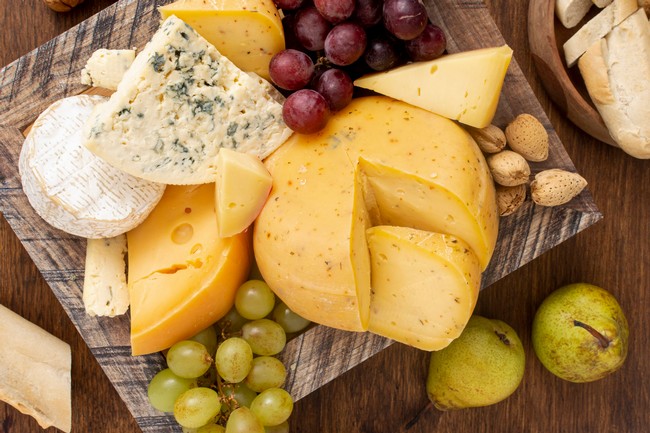
Cheese is a cornerstone of any Shavuot celebration, and this holiday offers a wonderful opportunity to elevate your experience with perfectly paired Israeli Kosher wines. While red wine and cheese are a classic combination, white and rosé wines offer a world of delightful flavor pairings waiting to be explored. To help you create unforgettable combinations on your Shavuot table, we'd like to share a few suggestions for pairings featuring delicious Israeli Kosher white and rosé wines, along with some cheese recommendations that will create delightful flavor experiences.
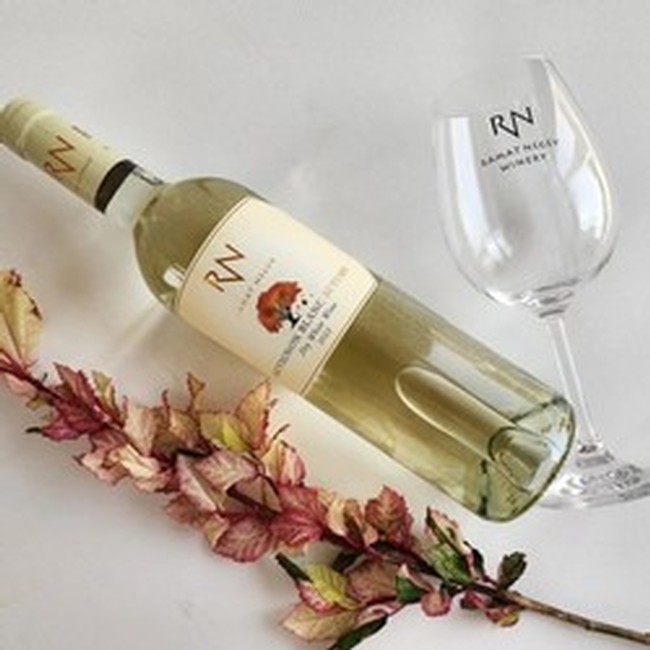
Ramat Negev Neve Midbar Sauvignon Blanc is a young white wine that boasts bright citrus notes and subtle herbal hints, making it a versatile companion for your cheese board. It gracefully elevates the flavors of creamy Brie, Gouda, Gruyère, or feta.
For a bolder pairing consider Asiago. Its strong aroma finds a delightful counterpoint in the lightness and dryness of the Ramat Negev Neve Midbar Sauvignon Blanc. The wine's acidity cuts through the cheese's richness, creating a balanced and refreshing taste.
Love goat cheese? Plain goat cheese with its rich tart flavor is also great with this versatile white. The Sauvignon Blanc's citrus notes will complement the cheese's tanginess, creating a harmonious pairing.
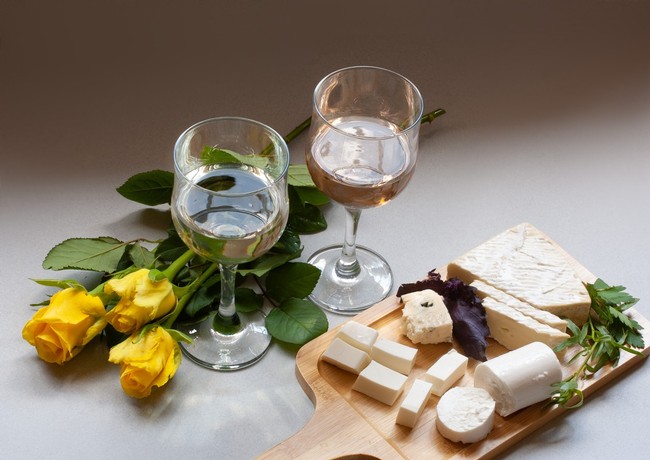
Ramat Negev Neve Midbar Chardonnay: Fresh and crisp with a wonderful combination of apple, pear, lemon, and pineapple flavors – no wonder these Ramat Negev wines from the desert are perfect for summer! This Chardonnay pairs beautifully with mild, semi-soft cheeses like gouda or a mild blue cheese. Fresh figs and nuts would be a delightful accompaniment!
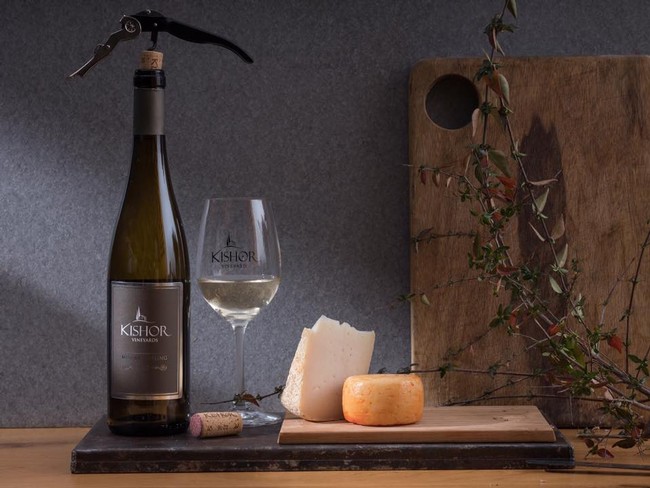
Kishor Misgav Dry Riesling is a lively wine bursting with aromas of exotic fruits, refreshing jasmine, and bright citrus. Soft cheeses like Brie and Camembert are classic pairings, but consider exploring harder, mild washed-rind cheeses like Emmentaler or Appenzeller for a delightful contrast with this elegant wine. For a softer yet equally delicious option, French Munster cheese is a match made in heaven. Its earthy funk dances playfully with the Kishor's fruitiness, while the creamy texture provides a luxurious counterpoint to the wine's refreshing acidity. Each bite becomes a symphony of flavor, leaving you wanting more.
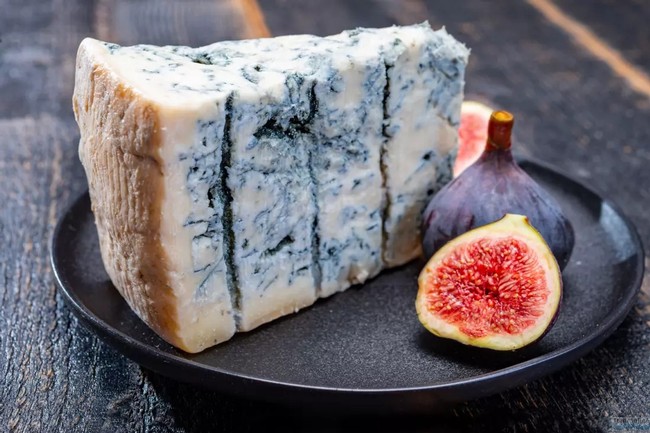
Kishor Viognier: This exceptionally well-balanced white wine boasts a luxuriously rich texture and a touch of buttery roundness. It's an ideal companion for creamy and buttery cheeses. Freshly baked bread with a crispy crunch adds another delightful dimension to the experience.
For a bolder pairing, consider piquant cheeses like gorgonzola. The Kishor Viognier's intriguing bouquet of orange blossom and ginger notes dances alongside the cheese's bold aroma. Meanwhile, the wine's flavors of melon, pear, honeyed orange, vanilla, and cream create a delightful counterpoint, harmonizing beautifully with the cheese's richness.
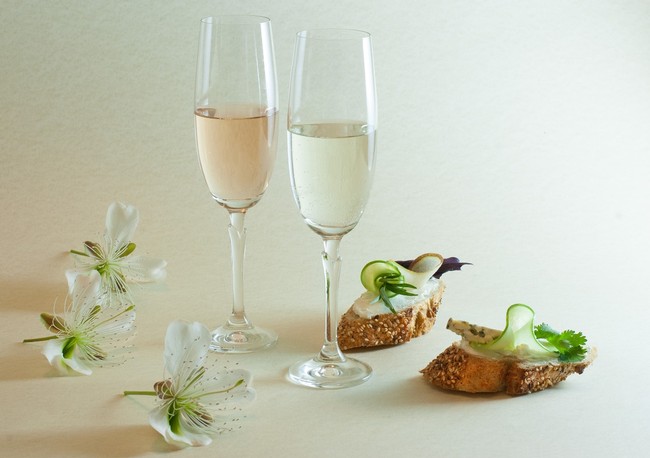
Kishor Kerem White: This beautifully golden and elegant blend of Sauvignon Blanc, Chenin Blanc, and Viognier offers a crisper profile than pure Viognier, with more citrus aromas. Its balanced character makes it a great companion for most soft to semi-firm cow's milk cheeses, such as triple-cream Brie, Gruyère, and cream cheese.
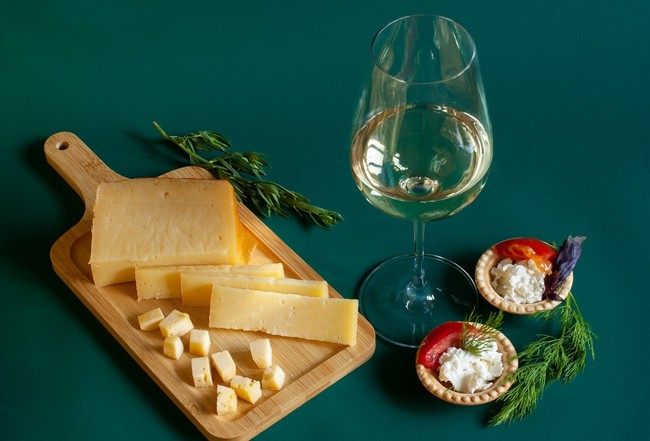
Agur Layam Blanc: This Roussanne-based blend with Sauvignon Blanc, Chardonnay, and Viognier offers a velvety complexity. The wine undergoes fermentation and aging on its lees in barrels for nine months, resulting in a rich profile. It beautifully complements cheeses like mild cheddar, Brie, and herb-crusted goat and sheep milk cheeses. The richness of this wine makes it a perfect partner even for Parmigiano-Reggiano, allowing the cheese's sharp notes to be balanced by the wine's body.
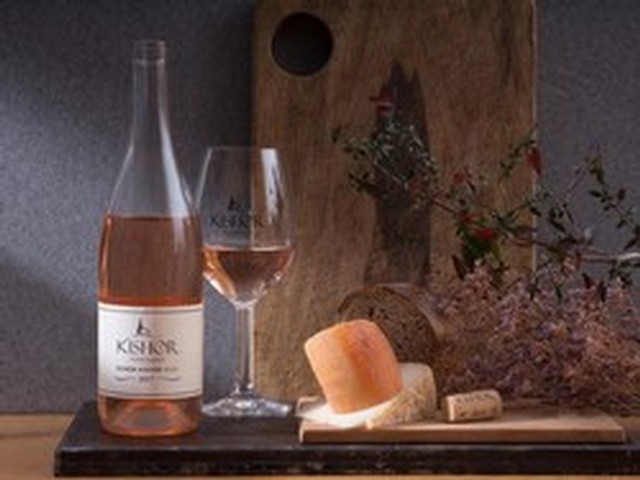
Kishor Rose is an elegant rosé crafted from 100% Grenache grapes. Dry, graceful, and lively on the palate, it boasts hints of red fruit, citrus, and herbs. This versatility makes it an ideal companion to a variety of cheeses. Enjoy it with cream cheese, or balance its bright acidity with the salty tang of fresh cheeses like feta or halloumi (don't forget a fresh ciabatta for dipping in olive oil!). Kishor Rose also complements young and even semi-firm cheeses, pairing well with baby Swiss or a young Cheddar.
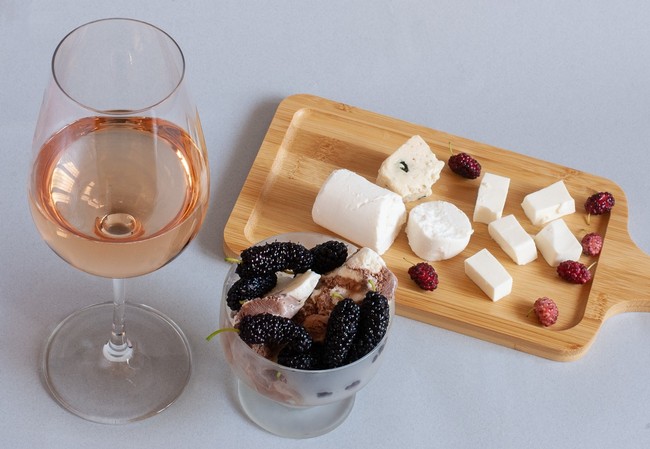
Provence-style Capsouto Cuvée Eva Rosé unfolds like a smooth and easy-drinking rosé, whispering its story through subtle, light-bodied characteristics. Delicate flavors of berry fruit, apricot, pear, and pineapple dance on the palate, their nuanced nature contributing to a silky texture. Crisp acidity adds a refreshing edge without becoming harsh, ensuring a balanced and harmonious experience. This smooth operator complements creamy textures beautifully, making it a perfect match for fresh goat cheese, Cantal, or Brie, where the wine highlights their gentle aromas.
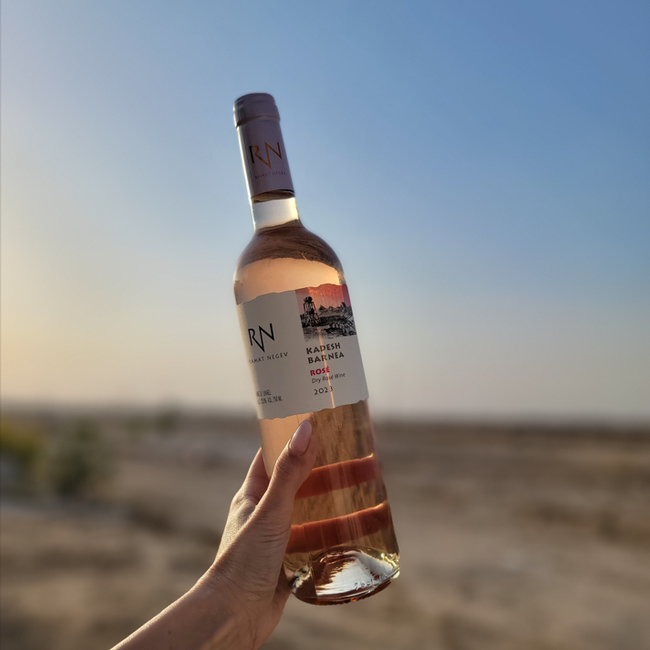
Ramat Negev Kadesh Barnea Rosé is crafted from 100% Cabernet Franc grapes, boasting a beautiful light pink-orange hue. A lively acidity keeps it refreshingly crisp, leading to a delightful, mellow finish with a whisper of peach. Perfect for cheese platters, especially those featuring piquant blue cheeses! It also complements fresh fruit and rich cheesecake beautifully, elevating every course on your Shavuot table.
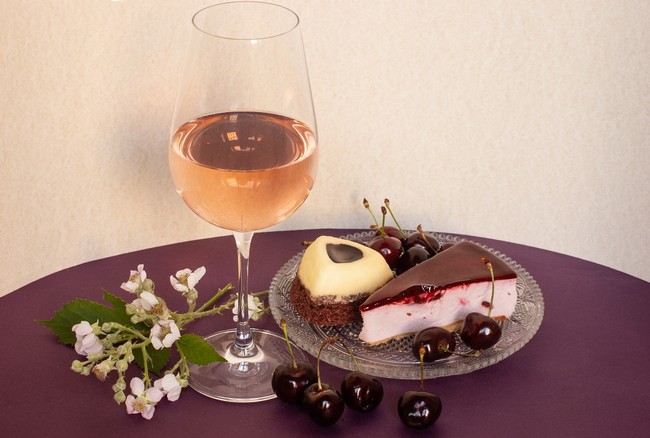
Final Touch
For an optimal wine and cheese pairing, temperature matters. Serve white and rosé wines slightly chilled (45-55°F) to enhance their crisp flavors. And for cheese, let it come to room temperature to enjoy its full flavor and texture.
Now, raise a glass, savor the delicious pairings, and celebrate the bounty of Shavuot with friends and family!
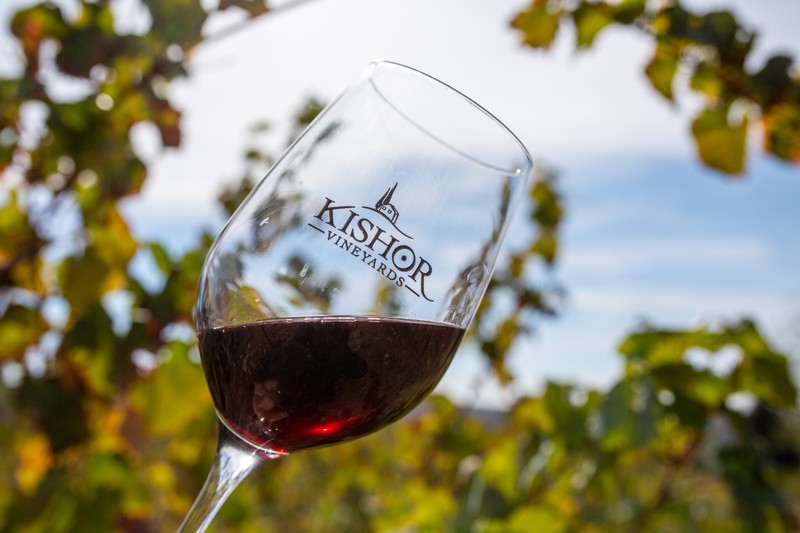
Nestled amidst the breathtaking beauty of the Upper Western Galilee, Kishor Winery transcends the ordinary vineyard experience. Founded in 2010 within Kfar Kishorit, a village for people with special needs, Kishor offers a unique tapestry woven with delicious Kosher wines, a rich history, and a deeply inspiring mission.
Echoes of a Forgotten Legacy

The land upon which Kishor Winery stands whispers tales of a bygone era steeped in winemaking. Standing proudly amidst the vines are ancient winepresses, unearthed testaments to a thriving industry that flourished over a thousand years ago. Imagine a magnificent wine route snaking through these very mountains around 1000 AD, dotted with vineyards and bustling with activity. Sadly, with the departure of the Crusaders and the Islamic conquest, the vineyards disappeared, leaving the land silent for centuries. Not a single vine graced these slopes for over a thousand years.
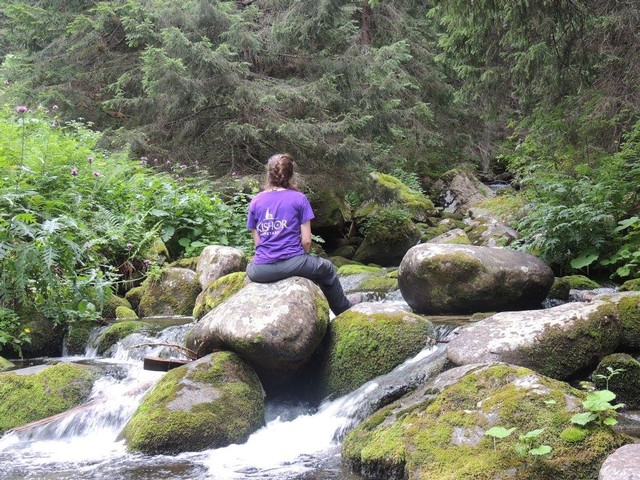
But today, the Galilee became the Tuscany of Israel. It is the most beautiful wine region of the country, with mountains, plunging valleys, stony ridges, running streams and thick forests. In the summer of 2007, a remarkable decision breathed new life into the land around Kfar Kishorit. Inspired by this unearthed legacy and a desire to empower their village members, the residents of Kfar Kishorit made a bold choice: to revive the age-old tradition of winemaking. Led by Richard Davis, the Professions Manager, and Itay Lahat, the Oenologist and Wine Expert, the team planted their first grapevines in 2007 and had their first harvest in 2010.
For such young vineyards, the quality of the grapes is extraordinary. This is no doubt a result of the expertise of Mr. Davis and Mr. Lahat, the dedicated work of all the Kishor employees, but also of the particular terroir of the Western Galilee, which contributes significantly to the grapes' excellence.
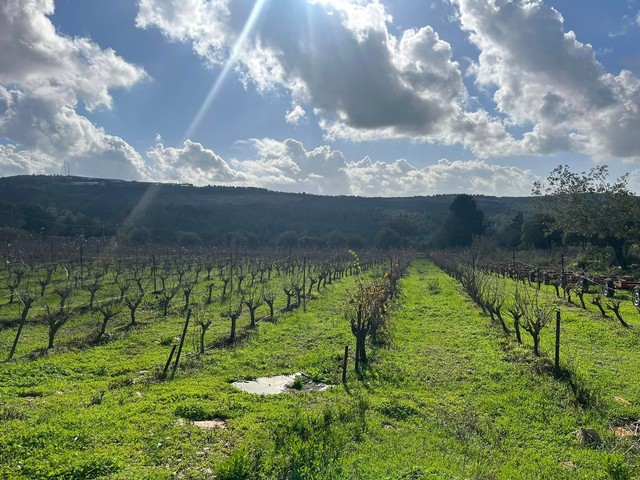
More Than Just Grapes: Cultivating Purpose
Today, Kishor boasts over 60 acres of meticulously cared-for vineyards. But what truly sets them apart is the deep and meaningful involvement of the village members in the entire winemaking process. From the meticulous pruning of the vines to the critical harvest at the perfect moment, and all the way to bottling and labeling the finished product, Kishorit residents are active partners in bringing Kishor wines to life.
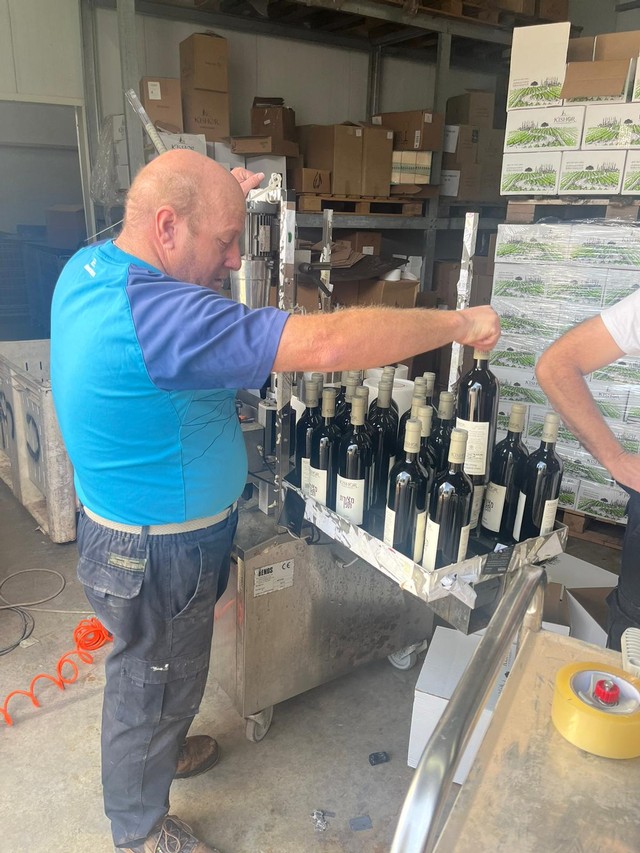
This involvement fosters a profound sense of belonging and purpose, while also providing valuable skill development opportunities. It transcends the act of winemaking, becoming a bridge that breaks down barriers and fosters understanding. Visitors from around the world are drawn to this unique connection, creating a beautiful tapestry of inclusion and empowerment.
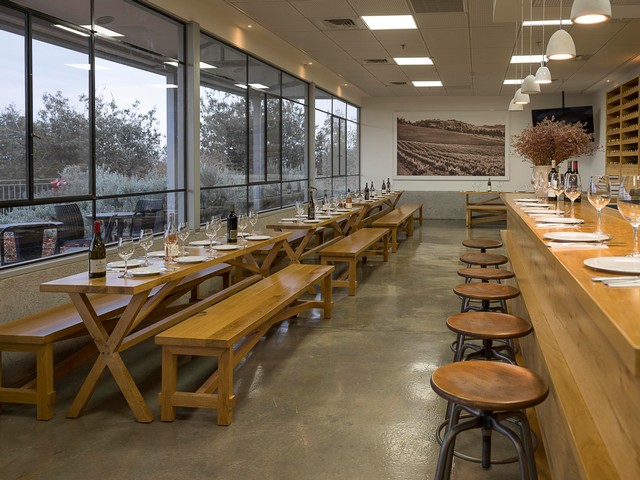
A Perfect Terroir for Exceptional Wines
The vineyards bask in the unique climate of the Galilee, experiencing dramatic temperature shifts between day and night. This diurnal rhythm, coupled with the characteristically rocky terrain, creates the perfect environment for slow and even grape ripening. Imagine cool nights preserving the grapes' natural acidity, while warm days coax forth intense flavors and sugars. This slow maturation process allows the grapes to develop a depth of flavor and complexity that translates beautifully into the finished wines.
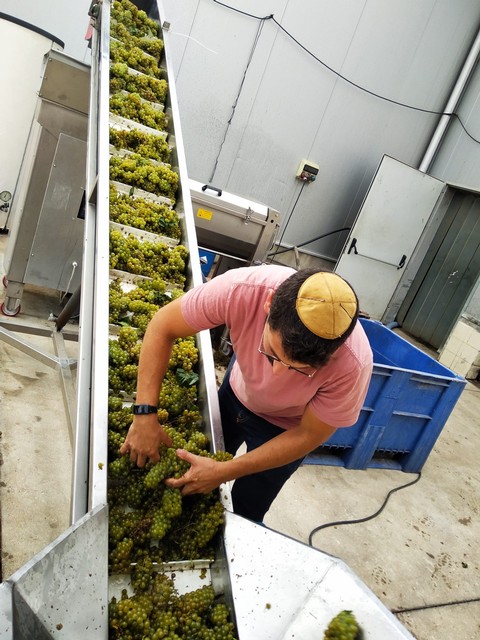
The Terra Rosa soil, rich in limestone deposits, provides the perfect mineral composition for flourishing grape varietals like Cabernet Sauvignon, Cabernet Franc, Petit Verdot, Syrah, Grenache, Sauvignon Blanc, Viognier, and Riesling. This diverse selection thrives in the Kishor vineyards, permitting the crafting of exceptional blended wines alongside single-varietal expressions like their award-winning Viognier. Each bottle is a testament to the dedication and skill that goes into Kishor's winemaking process.
Flagship Wine
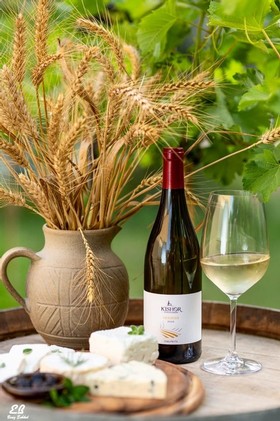
Unveiling one of the winery's most celebrated offerings, the Kishor Viognier, is a revelation for the senses. It’s an exceptionally well-balanced pale-gold wine, boasting a luxuriously rich texture with a touch of buttery roundness. It’s a symphony of white peach, orange blossom, and a touch of ginger on the nose, and flavors of melon, pear, and honeyed orange peel mingle together, accented by a touch of citrus on the palate. Light notes of vanilla and cream add a layer of complexity, while a whisper of herbal and mineral character lends elegance to the overall profile. The finish is exceptionally smooth, lingering pleasantly and leaving you wanting more.
This medium-bodied Viognier is not simply a delightful solo experience. Alive with crisp, vibrant acidity, it pairs beautifully with roast chicken or poached salmon, allowing the flavors to complement each other perfectly. Creamy and buttery cheeses and freshly baked bread find an equally delightful companion in Kishor Viognier. A true crowd-pleaser, this wine is sure to impress all wine drinkers, from novices discovering the world of Viognier to connoisseurs seeking a truly exceptional expression of the grape.
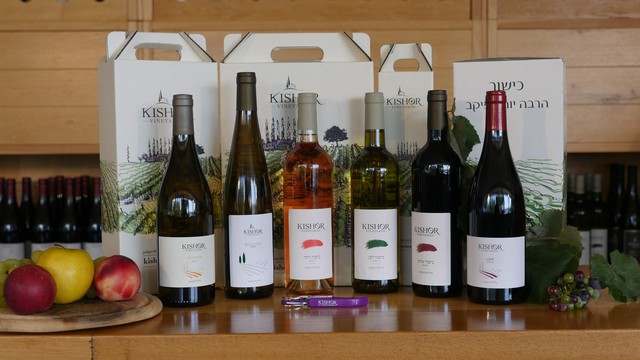 A Diverse Selection for Discerning Palates
A Diverse Selection for Discerning Palates
Beyond Viognier, Kishor Winery offers a diverse selection of wines to tantalize your taste buds:
One of the finest Kosher Rosés you'll ever encounter!
Kishor's GSM blend, a harmonious marriage of Grenache, Syrah, and Mourvèdre, that boasts intense fruitiness with a hint of spice.
Kishor Tefen Red, a Bordeaux-style blend that features earthy, green, and smoky-meaty notes.
Refreshing and delightful Rieslings.
And much more!

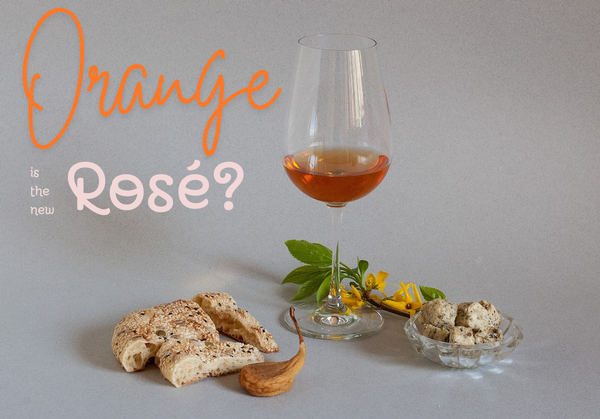
Orange wine has become a rising star in the world of wine, offering a captivating adventure for curious palates. But what exactly is it, and why is it suddenly all the rage?
Orange is somewhat akin to rosé, but sits within its own category. One way to understand it is as a "rosé inversion." Typically, rosé is crafted from red grapes with minimal skin contact, giving it a light pink hue. In contrast, orange wine uses white grapes, but the skins are left in the juice during fermentation, similar to red winemaking techniques. This extended skin contact is what gives orange wine its distinctive color and flavor profile.
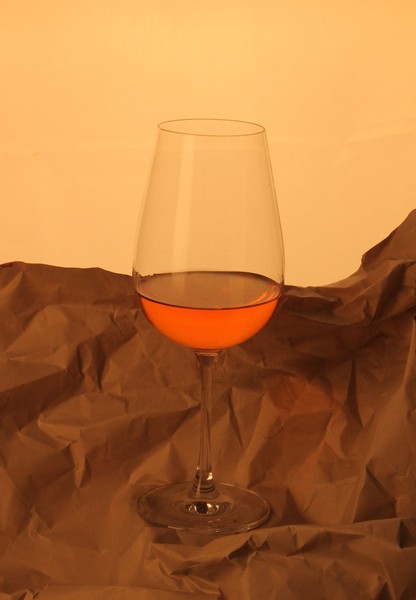
Orange wines boast incredible diversity, making them a captivating adventure for the taste buds. Unlike standardized white, red, and rosé production, orange wine is currently experiencing a period of unmatched flexibility in crafting. Any white wine grape varietal could be used. The length of skin contact determines the spectrum, with orange wines ranging from light and refreshing to bold, rich, and complex, mirrored in their captivating colors that span golden-orange to deep amber and copper. With all sorts of styles and flavors to explore, wine lovers of all palates can find a perfect orange wine for themselves.
Orange wine's complexity goes beyond color. The flavor profile is remarkably diverse, ranging from refreshingly floral, fruity, and citrusy styles to more complex expressions. With their nuanced profiles, these wines offer a surprising array of aromas, including tropical fruits, orange zest, ripe sweet apples, honey, hazelnuts, juniper, green tea, and herbaceous hints. This rich tapestry of flavors makes a single, definitive description challenging. Orange wines are so versatile that even if you dislike one, you might just fall in love with another.
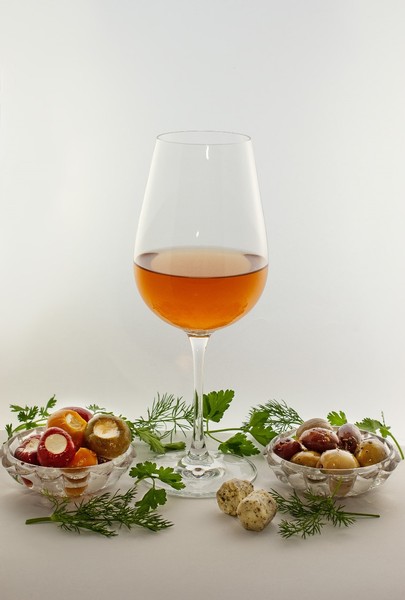
Being neither white nor red wines, orange wines excel at food pairings. They are bold enough for beef, but their delicate notes complement fish beautifully. Often dry with a touch of tannin and a full mouthfeel, they pair perfectly with Indian curry or spicy Moroccan cuisine. The vibrant acidity in orange wine cuts through the richness of fermented ingredients found in Korean and Japanese dishes. Truly a culinary chameleon, orange wine tackles strong-flavored dishes that can pose a challenge for other wines.
Orange wine's rise in popularity isn't just about its unique taste. The very fact that it's crafted from diverse grape varietals and boasts a unique character sparks conversation. Orange wine drinkers tend to be a curious bunch – inquisitive enthusiasts eager to learn. Ordering a glass becomes an invitation to explore, prompting your server's questions about your preferences and opening a gateway to a deeper understanding of the wine world. One could even say orange wine is the most social of beverages within the wine world.
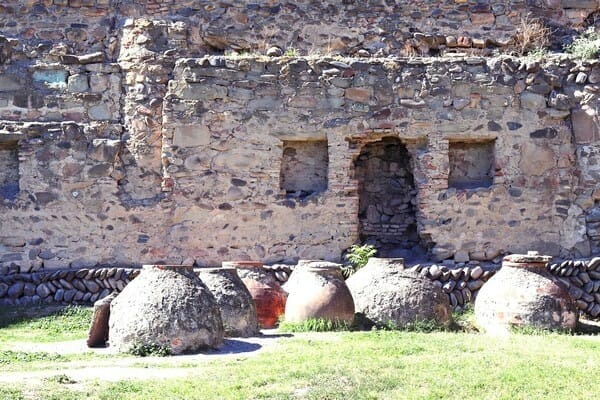
Orange wine's recent interest might make it seem like a new invention, but surprise! The techniques behind these intriguing wines stretch back an incredible 6,000 years, originating in what is now the country of Georgia. After all, Georgia and the Caucasus region proudly claim the title of birthplace of wine and winemaking.* Orange wines, therefore, offer a unique window into ancient winemaking.
Georgian winemakers used massive clay vessels called qvevri, buried underground for natural temperature control. This slow fermentation process, a cornerstone of Georgian winemaking to this day, imbues orange wines with their distinctive character. The grape of choice in Georgia is Rkatsiteli, an indigenous varietal renowned for producing wines with a deep, reddish-orange hue. Though internationally known as "orange wine," Georgians, the originators of this style, refer to it as "amber wine." Order it by this name next time for a touch of connoisseur cred!
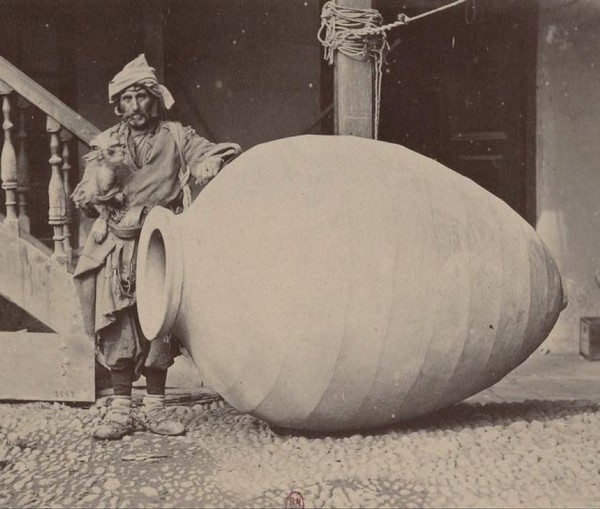
So these days we’re just re-inventing the great things of the past. Along with Georgia, today’s leaders in producing orange wines are Italy and Slovenia. ** This style has created a splash worldwide and is now found in many regions. In France, the Jura region boasts some well-regarded orange varieties. *** The New World has embraced the trend as well, with experimentation flourishing in Australia, Chile, California, and beyond.
Speaking of ancient traditions, Israel, a land steeped in wine history, is also exploring the world of orange wines. While Israeli orange wines are still a rarity in the U.S., a recent arrival, Ramat Negev Orange, offers a promising example. Hailing directly from the sun-drenched Negev desert, this harmonious blend of Pinot Gris and Semillon grapes yields a wine boasting a sunny orange hue, mirroring its desert birthplace. It's definitely worth trying!
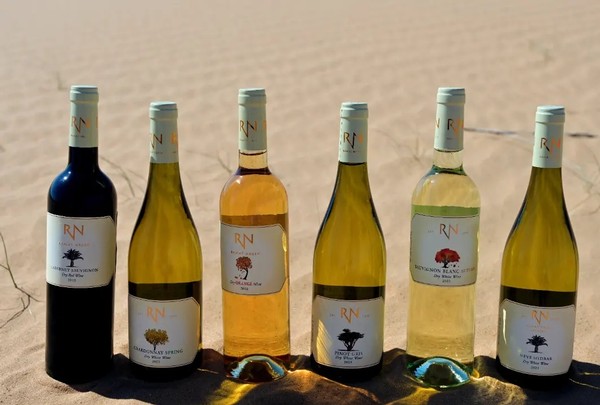
It turns out our current favorite is actually nothing new under the sun. The enduring human quest for delicious discoveries has been going on for millennia and shows no signs of stopping. So why not join this exciting journey?
* https://www.washingtonpost.com/lifestyle/food/you-say-orange-wines-the-georgians-say-amber-heres-what-they-all-have-in-common/2018/10/05/9a707aae-c805-11e8-b1ed-1d2d65b86d0c_story.html
** https://www.winebusiness.com/wbm/article/283683
*** https://winefolly.com/deep-dive/orange-wine/
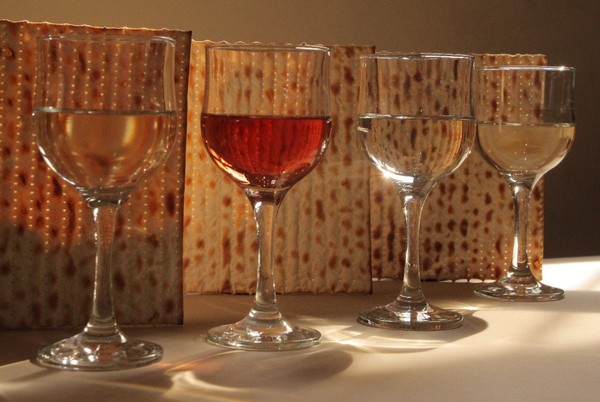
Wine boasts a rich history within Judaism, with archaeological evidence throughout Israel confirming its production thousands of years ago. Kosher wine is a product deeply rooted in tradition and spirituality. Jewish law dictates specific requirements for wine used in religious ceremonies. To be considered Kosher, the wine must follow kashrut, a set of Jewish dietary laws. This ensures its ritual purity and involves observant Jews overseeing every step of production, from crushing the grapes to final bottling.
Don't be misled by the term "Kosher wine” – it can be just as delicious and varied as any other type of wine. Made from a range of grapes, Kosher wines come in all the familiar styles: red, white, rosé, dry, sweet – you name it. The winemaking process itself, from fermentation to aging, is also identical to non-Kosher wines. So, what makes a wine Kosher? It simply means it adheres to a set of religious regulations. The focus on quality remains the same – the grapes, the climate, the soil, the sunshine, and the expertise of the winemaker are all paramount. In fact, many Kosher wines produced today are considered premium, offering deeply pleasurable experiences for your palate.
A small percentage of Kosher wines undergo a heating process called 'mevushal,' meaning "cooked" in Hebrew. This allows anyone, not only observant Jews, to handle an opened bottle without affecting its Kosher status. In the past, mevushal wines were indeed boiled, sacrificing flavor. Today, a gentler flash-pasteurization method heats the wine to 175°F and rapidly cools it to 60°F, minimizing the impact on taste.
To qualify as Kosher for Passover, wine must meet stricter requirements than regular Kosher wine. Since Passover forbids the presence of hametz (leavened grain products), Kosher-for-Passover wines must come from facilities entirely free of bread, dough, grains, and leavening agents. This extends to the clarification process, where the specific mold used cannot have been grown on grain. Sugar or fruit-based mold are acceptable alternatives. While this may seem like a more intricate production process, it doesn't affect the final taste of the wine. In Israel, many Kosher wines hail from small, boutique wineries. They often embrace sustainable practices, using organically grown grapes and crafting their wines with meticulous attention to both Kosher standards and exceptional quality.
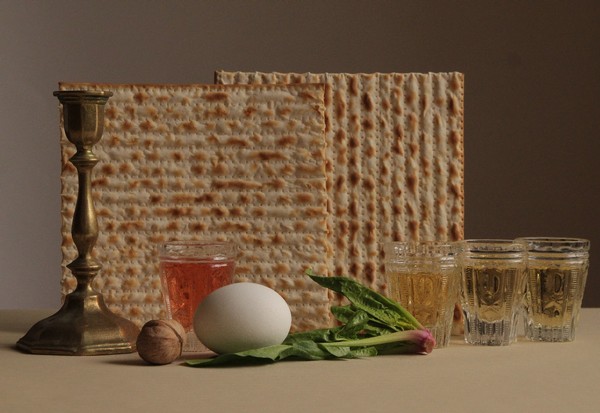
This week, as we celebrate Passover, no Seder dinner is complete without wine. The Seder wine carries great significance, symbolizing the Jewish people's journey from slavery to freedom. The four cups of wine, consumed throughout the ceremony, are steeped in layers of meaning.
The most prominent meaning connects each cup to a stage in the Israelites' liberation from Egyptian slavery, as recounted in the Exodus story. But the symbolism goes deeper. Another interpretation links the four cups to the four holy mothers: Sarah, Rebecca, Rachel, and Leah. Their strength and resilience are seen as foundational to the Jewish people's very existence and, ultimately, their redemption.
Further interpretations connect the four cups to the four symbolic foods of the Seder plate: bitter herbs (maror) that represent the bitterness of slavery; charoset: a sweet mixture with nuts symbolic of the mortar used by the Israelites during their labor in Egypt; eggs, representing the circle of life and resilience; and matzah: unleavened bread, symbolizing the haste of the Israelites' escape from Egypt, when there was no time for bread to rise.
Finally, the four cups can also symbolically correspond to the natural elements: earth, air, fire, and water. This represents the idea that true liberation is achieved only when our lives are in harmony, signifying a wholeness and completeness. Enjoying a delicious (and Kosher!) wine can be seen as contributing to this sense of harmony!
Chag Pesach Sameach! Happy Passover!
Day 3
We’re on to Day 3! So far, we have stayed in and around the Tel Aviv area. Today, we travel north! As a special treat, our IWD Israeli Representative, Tamir Ronen, who is our eyes, ears and taste buds on the ground in Israel, joins us today!
Tamir lives in the Moshav Mei Ami, just across the road from the Arab city Umm Al-Fahm. We pick up Tamir, have a quick cup of cappuccino (Israelis love their cappuccinos), and head to meet Meir Biton from Kitron Winery, at his home in the religious communal settlement Hoshaya.
The Kitron Winery is located in Netanya however they are currently building a new gravitational winery in the Lower Galilee. A gravitational winery, or “gravity flow” is typically built on multiple tiers, each tier for a different phase in the winemaking. This allows the wine to flow naturally, which enables the wine to preserve as much color and flavor as possible, rather than pushing the wine with air and pumps. Meir studied this kind of winemaking in Burgundy and in Sonoma and it will be the first and only one of its kind in Israel.

Image from: http://blog.winecollective.ca/wp-content/uploads/2013/07/GravityFlowProcess.jpg
We took our leave of Meir and his lovely home and headed to a meeting we were all particularly excited for because it will be a new winery for Israeli Wine Direct to represent this coming spring!
That’s right, we are proud to announce the newest member to the IWD portfolio: Kishor Winery! We are thrilled to bring you these new and excellent wines NOT only because of their outstanding quality NOT only because they are kosher and will be our 2 first KOSHER white wines but because the people and the story of Kishor is remarkable and is one we are proud to be a part of.

Kishor winery is located in the Western Galilee, nestled within beautiful rolling hills, a part of the Kishorit community, a home for a adults with special needs. Five of the members of Kishorit work permanently in the vineyards and winery, while more members come on to work during the heavy production season. All workers take part in every aspect of wine production, from grape cultivation and vineyard management to wine making, bottling, and marketing, and are managed by Richard Davis, a South African viticulturist and winemaker as well as Itay Lahat, oenologist and wine expert.
We arrived at the Visitor’s Center, a beautiful and modern building, recently finished, and were greeted by Richard Davis and Yair Una, head of marketing and sales, as well as Yaron Biran, a member of the community who works in the vineyard and winery. Yaron brings us a selection of cheeses, breads and vegetables, all grown, made and baked in Kishorit. If you get a chance to visit this magical place you MUST try the food! Perhaps the best spread of our tour!

Keep in mind that the vineyards were only planted in 2007. They harvest their first grapes only in 2010 and the permanent winery was finished only in 2013 so this is a baby winery, in its toddler years, but the wines they make are far more mature than their age! First production yielded 9,000 bottles; by 2013 they had grown to making 34,000 bottles and are seeing a future of over 55,000 bottles so their growth is exponential!
To the wine! Their vineyards are terra rosa and limestone and the unique micro-climate of the region helps them grow grapes of excellent quality. Of the grapes they grow, 7 are red (Cabernet Sauvignon, Cabernet Franc, Petit Verdot, Merlot, Syrah, Grenache and Mourvedre) and 3 are white (Sauvignon Blanc, Viognier and Riesling). They have just started to bottle the Syrah and next year will begin with the Mourvedre and Grenache.
We will carry 4 of their wines: Kerem Kishor White (blend of Sauvignon Blanc and Viognier), Savant Viogner (100% Viognier), Kerem Kishor Red and Savant Red (both blends of Cabernet Sauvignon, Cabernet Franc and Petit Verdot).

Now the moment you (and we) have all been waiting for: the tasting! The first we try is the Kishor White 2013. It is a dry wine, well balanced, expertly made; drinkable, highly enjoyable.
Next we try their Riesling, which we don’t carry as of yet. We tasted the 2012, which was one of the last bottles from that vintage, but Richard remarked that with each year, their Rieslings are getting better and better. What we tried was still a very good Riesling. It was sweet and fruity with a nice dry finish that kept the wine from being too sugary. It had a slight petrol odor to it which sounds much more unpleasant than it actually was. The wine was excellent! Could easily last another 10+ years.
Richard indulged us next with trying their Rose. Made from 100% Merlot grapes, which are grown specifically for making this rose, it had a beautifully salmon-orange tinge to it. The wine is crisp with a good acidity and a refreshing bouquet, a result of early picking.
Next, we moved on to the reds with the Kerem Kishor Red; a dry medium-light bodied wine with a smooth, long finish that isn’t tannic. It is a wine that can be easily had now but will age well over the next 5-8 years.
Lastly, we tried the Savant Red, a similar blend to the Kerem Kishor Red, made from Cabernet Sauvignon, Cabernet Franc and Petit Verdot, it has a greater, almost entirely quantity of Cabernet Franc. As such, it is light and peppery with a hint of raspberries. It will be a wine that shall be greatly enjoyed by our customers, it’s that good!
After chatting for over three hours with Richard and Yair, we took our leave, elated to have tried these outstanding wines and to have met these impressive people. And excited to be bringing these wines here to the States; we hope you are, too!
Day 2
The first day was a fantastic start to our trip! Unfortunately, the weather on the 2nd day put a bit of a damper but our meeting with Midbar owners Itzhak and Shelly Wolf more than made up for the unusually cold and wet Israeli winter.
We met at their beautiful apartment in Kikar Hamedina, the largest plaza in Tel Aviv with chic stores and quaint cafes. Originally, we were going to travel south to the winery in Arad to see them and vine grower, Eran Raz, but the weather prevented us from doing so. It is unfortunate because they had scheduled for that day a religious ceremony to make the winery kosher. That’s right, readers; Midbar Winery will now be producing KOSHER wines! More on that a little later but it is a very exciting announcement.


As always with winemakers, wine importers and wine lovers alike, when you have a meeting, you must have some wine; and maybe a little something to eat, too. We started right off with their 2013 Unoaked Chardonnay, which we have never tried before. It was crisp and fruity, with a pale yellow, almost greenish color. Not as tart as the Pelter Unoaked Chardonnay that we already carry, but just as refreshing. Our customers in the States have always enjoyed the white wines we import from Israel so the hunt to find new and delicious white wines is always on!
Next we tried the Viognier; we carry the Midbar White 44 and have sold out of the Southern White, which both contain this special grape, but what we tasted was a 100% Viognier, and we loved it. It was floral and buttery, rich and full bodied yet still dry, so golden in color one would almost think it’s a sweet wine, like a Sauterne. The Viognier impressed us, the Midbar blends are all enjoyable but the single varietal wines, which Itzhak explains, he only uses the best grapes for, are truly spectacular. When you realized that the winery is still young, the quality becomes even more impressive and the promise of what to come makes it all the more exciting and enjoyable!
Since the rain hadn’t abated yet and it was our only meeting for the day, we indulged in a few more samples of wine, moving on to the reds. The first one was the Red 55, which we unfortunately don’t carry, but was remarkable. Asking Itzhak why they chose “55” in the name, he answered that they were looking to create a memorable number with no particular meaning, perhaps only a mystique, like Heinz 57. Back to the 55, it is a blend of Cabernet Sauvignon, Merlot, Petit Verdot and Cabernet Franc. The wine is smooth and subtle, with a light finish. The Wolfs don’t like tannin in their wine and that cannot be anymore evident than in the 55. It has a deep garnet color and the bouquet is heady with perfume.
Our last wine was the 2013 Cabernet Sauvignon 800, which we do carry, but the 2012 vintage. According to Itzhak, this is exactly the wine that defines Midbar Winery, “for the good and the bad, its exactly a desert wine”. If you tasted the wine, you already know its quality. If you haven’t had it yet, do! It tastes of blackberries and pine with a soft, earthy finish.
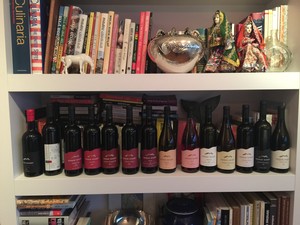
The conversation moves to Midbar’s becoming Kosher and what that has meant for the winery. To put it simply, it was done to increase sales, once a winery grows to a certain size in Israel, it makes no sense not to go Kosher. Many people ask if that will have an effect on the quality… it will not! By becoming Kosher, the winery simply needs to be overseen by a Mashgiach, or a religious supervisor. It sounds perhaps a bit less complicated than it really is; but basically once the grapes are harvested, the entire wine production up to shipment, basically, needs to be run by these religious men in order to guarantee Kashrut. The wine maker, Meital Damry, even Itzhak and Shelly, the company’s owners, can’t taste their wine in the barrels, unless the Mashgiach is there to serve it to them! It’s a complicated process for an ancient belief but rest assured, the wine will remain as great as it ever was and with the coming years and the growing experience of those working at Midbar, it will probably get better!
Day 1
We landed in Israel and immediately hit the ground running. The morning after we arrived, we had a meeting with Margalit Winery. Still groggy from jetlag, we started our trip with a brief tour of the winery with winemaker Asaf Margalit.

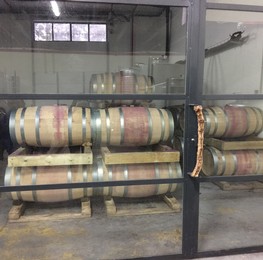
Margalit Winery and barrel rooms
He showed us their beautiful barrel room before taking us upstairs to a cozy tasting room. We started talk about Margalit wines, one of the biggest cult wineries in Israel. Shortly before opening the first bottle, we were joined by Yair, Asaf’s father, founder and master winemaker at Margalit. Yair could probably be the man credited with starting the boutique winery movement in Israel. A chemist in training, he holds a PhD in physical chemistry, which brought him to California U.C. Davis as a visiting research professor. It was there that his love of wines was, for a better term, cultivated. That was thirty years ago. He went on to be Tishbi Winery’s first winemaker before founding Margalit Winery in 1989. Aside from producing some of the best wines Israel has to offer, he has written not just one but two leading books in wine technology, chemistry and production. If you want to read up more on Yair and his background, read this excellent article written last summer in the Jerusalem Post HERE.
Back to our tasting. Never mind breakfast (although there was a beautiful spread of freshly cut vegetables, burekas, cheese and bread, lets have some fruit salad! Ok ok, by fruit salad, we mean wine. Who says we can’t mix business with pleasure?
Array of wines and food
We try the Merlot, which will be a new wine for us to carry this coming spring. It is a perfect Merlot, full of those quintessential cherry, tobacco and chocolaty flavors. Beautifully balanced, easy tannin & rich, this will please all of our red wine-loving customers.
Next we move on to the Cabernet Sauvignon and the Cabernet Special Reserve, two of their signature wines. Many of our customers will already be familiar with the amazing quality of these wines. They are outstanding, perhaps the two wines that Margalit is best known for.
We try a few more wines, a Petit Verdot that is an in house wine only. It has that characteristically grapey, vanilla and spice flavor one expects to find in Petit Verdot, albeit very tannic, which is why they decided not to put it on the market.
Lastly, we try an experiment of the winery, a rose! Now, we carry 3 roses from 3 different superb wineries and are always excited to try more. Sure, they may be considered the fluff of wine, but when it’s hot out, there’s nothing like opening a bottle of crisp rose. Yair explains that they have made a rose that they believe to be exactly what a rose should taste like. We have to agree; it is very good. Crisp! That’s definitely the first word. It was approaching the end of fermentation so there was a slight carbonation to the wine, which made it no less enjoyable. It was fresh, lively, and springy, with grassy and strawberry notes. Will they put it on the market? Let’s hope so!
Arie Hochberg, IWD Principal and Asaf Margalit, Winemaker
We take our leave of the Margalits. The weather appeared to be getting hazier, there was a storm forecasted, or maybe it was just the wine…
We have one more appointment scheduled for the day at Somek winery, with vintner and Zichron Yaakov native, owner of Somek Winery, Barak Dahan. In fact, Barak isn’t just a native, he is the fifth generation of his family to be living in Zichron Yaakov and the family has been tending the same vineyards all that time! In fact, the vineyard Barak still cultivates is the same land, albeit a bit more has been accumulated over the years, that Baron de Rothschild gave to his family over a century ago!

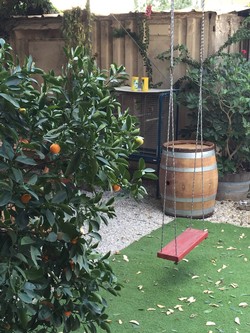
Backyard of Somek Winery
For those who know wine in Israel, the town may be familiar to you, because it came under the patronage of Baron de Rothschild in 1883, when he came to Israel to survey land for agriculture, particularly vineyards. He founded a winery in the Carmel Mountains and set up a bottling plant in Zichron Yaacov, the town was renamed in memory Rotheschild’s father, James (“Ya’acov) and in 1954, Baron de Rothschild’s remains were reinterred close to the town.
The Dahan family cultivated their land and sold the grapes to wineries for decades. Finally, ten years ago, Barak and his wife, Hila, decided to expand upon their knowledge and begin making their own wine. Hila then went on to study viticulture and oenology at the University of Adelaide, in Australia. A decade later, their winery has grown, along with their knowledge.

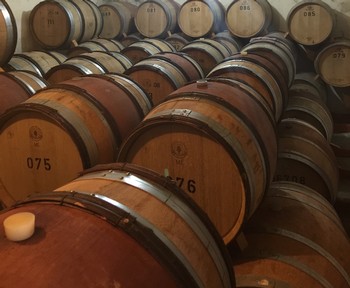
New barrels and wine presser; barrel room
We carry several labels by them, all of them fantastic, one of the most notable, perhaps, is their Carignan, a beautiful wine with a wonderful, round texture, firm tannins, and ripe fruits. Another wine that is perhaps less popular, though no less delicious, is the Bikat Hanadiv. In Hebrew it means “blessings of the righteous man”, Barak’s and Hila’s praise of Rothschild. It is a blended wine of 50% Cabernet Sauvignon, 30% Merlot, 15% Cabernet Franc and 5% Petit Verdot and was so named because it is reminiscent of the famous Chateau Lafite.
Barak and Hila are have become very knowledgeable winemakers indeed, they are gaining recognition, and rightly so, for the wines they are producing. A year ago, the Jewish Daily Forward wrote a wonderful article, linked HERE, on the Dahans and their wines. Currently, they are even expanding on what they know and are starting to make new wines, one of which, a chardonnay, we were very excited to try. We sit in the newly built, lovely tasting room and sip the sample Barak has brought for us. Like the rose from Margalit, it is still undergoing fermentation, so it also has slight carbonation that will eventually dissipate. The wine will be slightly oaked, to round out the burst of citrus, and will be just as superb as his other wines.
The day is getting a bit more precarious. The chickens in Barak’s coop seem to understand that there is a storm coming. Wintertime in Israel is no joke! As we leave the winery, the gusts of wind almost force us back inside. Sad to go, Barak is so inviting and generous with his time and explanations, the conversation was endless and could have gone on longer, we take our leave, excited by all we have learned and tasted in the first day alone! What a successful start to our winery tour, the excitement would not let up, regardless of how much the weather tried to dampen it!
Arie Hochberg and Barak Dahan
Some people own vineyards or wineries because they were born into a winemaking family. Others buy vineyards and start wineries for their love of wine. Still others consider winemaking a profitable venture and pursue winemaking from a business point of view. For us in Meishar Winery, the story is different.
Meishar is a small village, about a 30 minute drive from either Tel-Aviv or Jerusalem, 15 minutes away from the Mediterranean coast and only a couple of miles from the small town of Gedera.

Meishar is a moshav – a type of settlement where the community owns the land and leases it to families. Polish immigrants, mostly holocaust survivors, started Meishar in 1951. At the time, each family received from the government two cows, a few chickens, a donkey and cart and a simple 230 sq. ft. home to start their new life. In those years, this part of Israel was considered wild and remote; in winter, the dirt roads turned to mud, and in summer, the newly made farmers had to deal with scorching heat, thorns and poisonous snakes. In addition to the cows and chickens, the moshav planted a large, commonly owned, citrus orchard. At the time, citrus growing was the main Israeli export; much of the village soil was medium to heavy – just right for citrus. Three of the 60 family farms of Meishar had very sandy soil – too sandy for citrus. These few families received alternate plots to plant their citrus groves.
Nearly forty years later, in 1989, we came to Meishar. By then the country had made much progress, travel was fast and easy, and the number of inhabitants grew to over 7 million. Agriculture was playing a much smaller – an almost negligible part in the national economy, now based on high-tech and other advanced exports. Water was becoming scarcer while wages were growing higher. When we bought the farm in Meishar, the orange groves planted in the early 1950s were still gloriously green as far as the eye could see, but very soon they began to be cut down, until by 2005 they were all gone (today, as recycled water begins to flow in, citrus groves and avocado orchards are beginning to be replanted). The farm we bought was one of the three farms that were considered too sandy for citrus growing. Looking out from the house we bought and renovated (Mr. Klepeter, the previous owner, an architect from Vienna, enlarged it two times – in 1962 from 230 to 400 sq. ft, and in 1968 to 2200 sq ft, adding a large living room and a second floor; we kept the outer structure and re-did the interior) – we saw a plot of about 4 acres, that was probably never cultivated: not by the people of Meishar, since it was considered too sandy; certainly not by anyone before them, since there is no water here for intensive agriculture, except for a few months during the winter. Most probably, these fields were used for grazing by the sheep and goats of the Arabs and Bedouins who lived in nearby villages until 1948; possibly by the crusaders before them; by the Byzantines before them; and without doubt by the Philistines who lived exactly in this area in the famous days of David and Goliath, Samson and Delilah.

We stood on our new porch and looked at our new, sandy property and wondered what to do with it. Each of us had a full-time job – my wife a teacher, myself a high-tech engineer. We had two little children. Our hands were full, our bank account empty (after buying the farm and making the house habitable). But the land didn’t let us turn our back on it. As the bible says: “The Lord God took the man and put him in the Garden of Eden, to work it and take care of it” (Genesis 2, 15). So, even though we are not religious in the orthodox sense of the word, we felt, and still feel, compelled to work the land, with our own hands whenever possible, and take good care of it- and certainly not allow it to lay uncultivated, breeding weeds, thorns and snakes.


Our new piece of land in 1990, in winter (left) and summer (right). Note the old orange groves on the hill across.
There is an additional point. Labor, especially farm labor, and in particular manual labor, plays an important part in my family. My grandfather, Zeev Smilansky, after whom I am named (he died 10 years before I was born), was one of the first Zionists to arrive here, from what is today Ukraine, all of 18 years old, and carrying two books with him – the bible in the proverbial one hand and Tolstoy in the other, determined to create a new, healthy, just and moral Zionist society, a home for Jews who would work the land with their own hands and live by the sweat of their (own) brows. Indeed, he was, by choice, a manual laborer for most of his life, writing learned articles on economy and politics at night, in a tent, with a candle for light, after a hard day of plowing the fields with the mules. He was a member of the Gordonist movement of the “religion of labor”, calling for personal liberation through manual labor. Anyone who is interested can (and should) read about these times in “preliminaries”, the wonderful semi-fictionalized biography of my father and his parents.

My grandfather Zeev, grandmother Miriam, father Yizhar, aged 3, and his brother Israel, aged 9, in 1919.
So this is how we came to plant a vineyard and start a winery: we had about 4 acres of sandy land, unfit for oranges, which were never properly cultivated. And we felt that we had no choice but to plant and cultivate it. We also had a small hobby of making homemade wine. Some research showed that vineyards needed much less water than oranges – about 150 cubic meters per dunam (1000 sq meters) vs. 850 for oranges; That vines are very sturdy; that they are grafted, so you can select the rootstock according to the soil type, and the scion according to the grape type – cabernet, merlot, shiraz etc. Thus, in 1992, we planted the first plot of Cabernet, with “saltcreek” rootstock that is most fit for sandy soils. Our unique sandy soil allows the roots of our vines to be 30 feet deep that most years require no irrigation thus producing small quantities of unique and very special tasting wines.
Israeli Wine Direct is our exclusive importer in the United States and is proud to offer you four of our top wines and in conjunction with this blog a 10% discount good through November 10th.


The vineyard in February My two sons - Ofer (left) and Shaul (right) in the vineyard.
Our wines – purchase at: http://www.israeliwinedirect.com/products/brand/Meishar
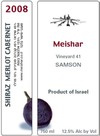 Meishar #41 – 2008 - A blend of Shiraz, Cabernet with some Merlot, this well rounded wine has medium body, with strong aromas of ripe purple fruits and bright flowers with a hint of forest berries. In the mouth the Shiraz is strongly felt with layers upon layers of fruit with a hint of herbs and toasted nuts. Goes well with any accompaniment - beef, pasta, hearty soups, and cheese. Ready to drink but can keep until 2016.
Meishar #41 – 2008 - A blend of Shiraz, Cabernet with some Merlot, this well rounded wine has medium body, with strong aromas of ripe purple fruits and bright flowers with a hint of forest berries. In the mouth the Shiraz is strongly felt with layers upon layers of fruit with a hint of herbs and toasted nuts. Goes well with any accompaniment - beef, pasta, hearty soups, and cheese. Ready to drink but can keep until 2016.
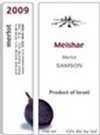 Meishar Merlot (2009) - Medium to dark ruby in the glass, aromas of green herbs and lush fruit with a hint of spices. In the mouth the wine opens to layers of red berries and stony minerals. Long finish. Excellent with spicy foods, light meats, spicy cheese and dark chocolate. Ready to drink but can improve until 2018.
Meishar Merlot (2009) - Medium to dark ruby in the glass, aromas of green herbs and lush fruit with a hint of spices. In the mouth the wine opens to layers of red berries and stony minerals. Long finish. Excellent with spicy foods, light meats, spicy cheese and dark chocolate. Ready to drink but can improve until 2018.
 Meishar Vinyard 730 (2010) - The flagship of Meishar Winery, not made each year. 100% Cabernet Sauvignon, medium to dark garnet in the glass, aromas of toasted spices, characteristic licorice and cedar aromas. In the mouth exceptional spices, red berries, pepper, and wet forest floor. Exceptionally powerful and balanced. Ready to drink now but will definitely mature well until 2020 at least.
Meishar Vinyard 730 (2010) - The flagship of Meishar Winery, not made each year. 100% Cabernet Sauvignon, medium to dark garnet in the glass, aromas of toasted spices, characteristic licorice and cedar aromas. In the mouth exceptional spices, red berries, pepper, and wet forest floor. Exceptionally powerful and balanced. Ready to drink now but will definitely mature well until 2020 at least.
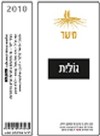 Meishar “Goliath” (2010) - A unique blend of Shiraz, Cabernet and Merlot, made only in exceptional vintages. Medium body and medium to dark garnet in the glass. Aromas of black berries and smoky toasted spices give way to chocolate and tobacco. In the mouth spices, ripe purple fruit, pepper, rich spicy fruitcake and wet forest floor. Wonderfully balanced. Ready to drink now but will mature well until 2025.
Meishar “Goliath” (2010) - A unique blend of Shiraz, Cabernet and Merlot, made only in exceptional vintages. Medium body and medium to dark garnet in the glass. Aromas of black berries and smoky toasted spices give way to chocolate and tobacco. In the mouth spices, ripe purple fruit, pepper, rich spicy fruitcake and wet forest floor. Wonderfully balanced. Ready to drink now but will mature well until 2025.